Swagger(狂神说Java)(内含教学视频+源代码)
教学视频+源代码下载链接地址:https://download.csdn.net/download/weixin_46411355/87415614
目录
- Swagger(狂神说Java)(内含教学视频+源代码)
- `教学视频+源代码下载链接地址`:[https://download.csdn.net/download/weixin_46411355/87415614](https://download.csdn.net/download/weixin_46411355/87415614)
一、学习目标:
- 了解Swagger的作用和概念
- 了解前后端分离
- 在SpringBoot中集成Swagger
二、Swagger简介
前后端分离
Vue + SpringBoot
后端时代:前段只用管理静态页面;html==>后端。模板引擎JSP=>后端是主力
前后端分离式时代:
- 后端:后端控制层,服务层,数据访问层【后端团队】
- 前段:前段控制层,视图层【前段团队】
。伪造后端数据,json。已经存在了,不需要后端,前段工程依旧能跑起来 - 前后端如何交互?===>API
- 前后端相对独立,松耦合;
- 前后端甚至可以部署在不同的服务器上;
产生一个问题:
-
前后端集成联调,前段人员和后端人员无法做到,“及时协商,尽早解决”,最终导致问题集中爆发;
解决方案: -
首先制定schema【计划的提纲】,实时更新最新API,降低集成的风险;
-
早些年:指定word计划文档;
-
前后端分离:
。前段测试后端接口:Postman
。后端提供接口,需要实时更新最新的消息及改动!
Swagger
- 号称世界上最流行的Api框架
- RestFul Api文档在线自动生成工具=>Api文档与API定义同步更新
- 直接运行,可以在线测试API接口;
- 支持多种语言:(JAVA、PHP)
在项目使用Swagger需要springbox jar包
- swagger2
- ui
三、SpringBoot集成Swagger
3.1.新建一个SpringBoot的web项目
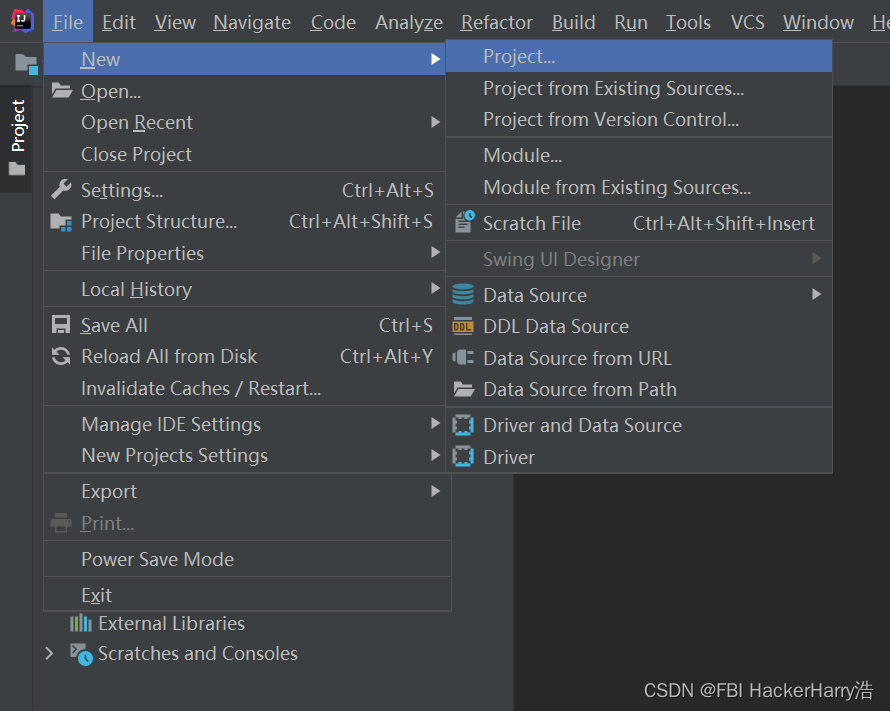
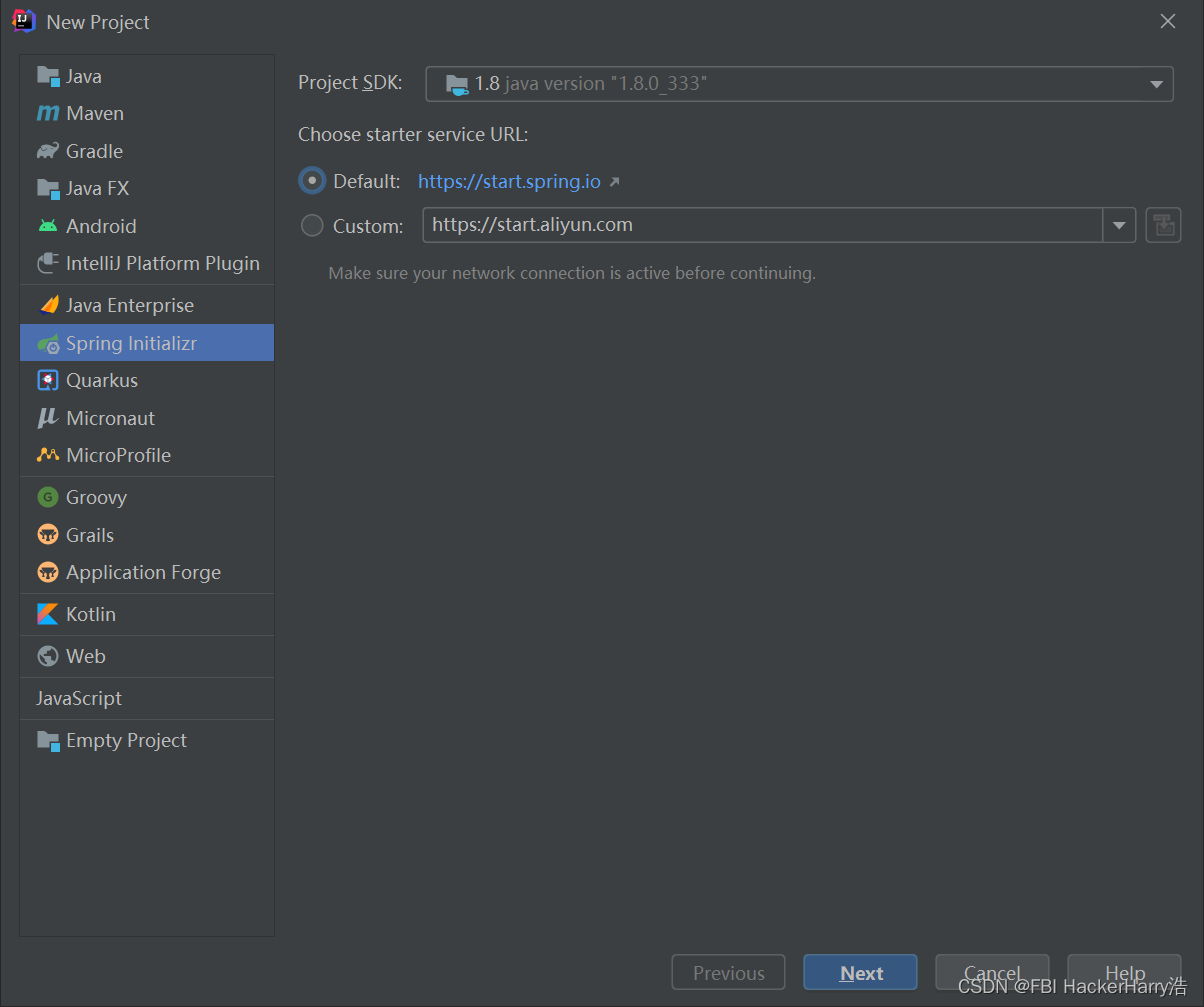
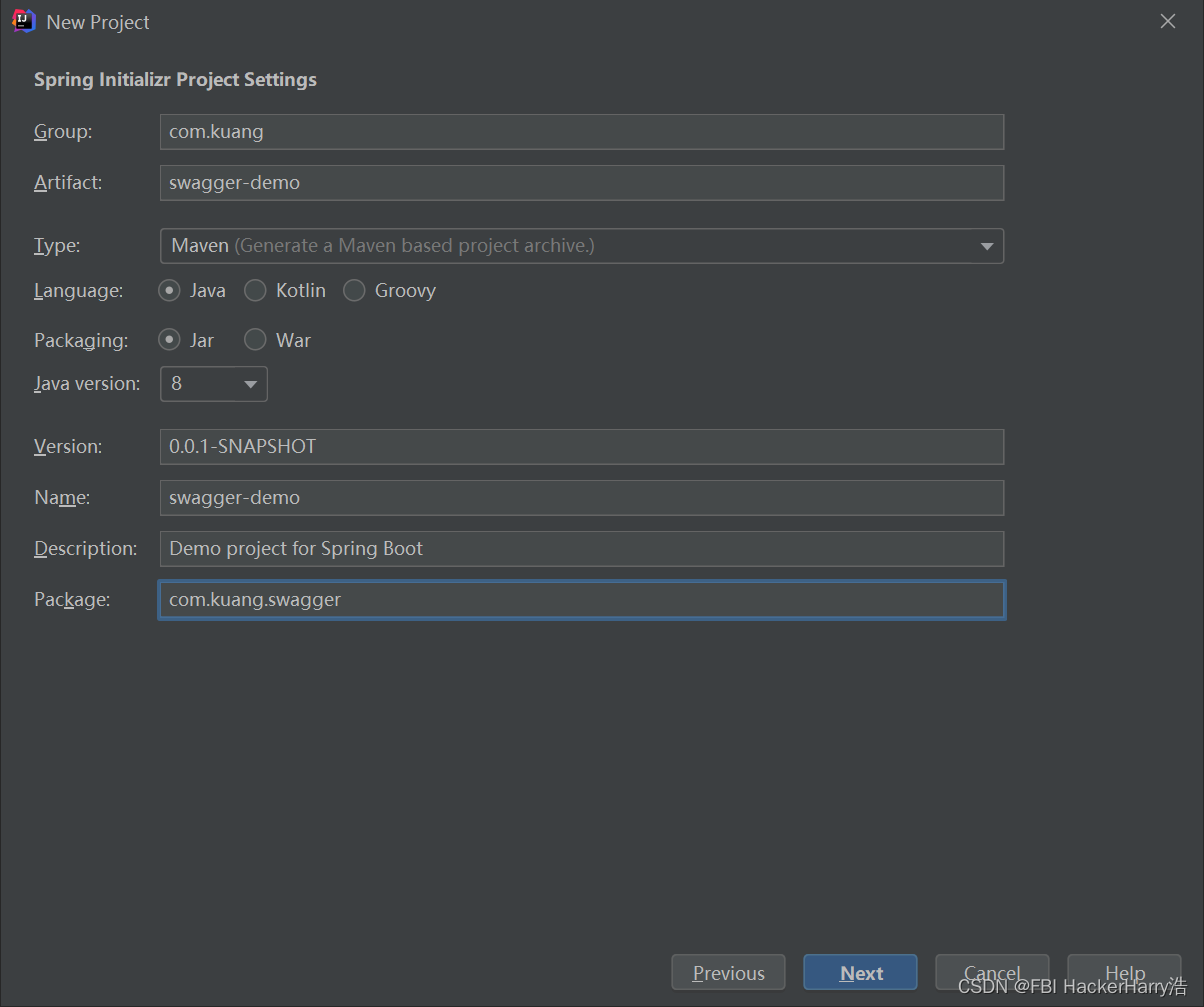

3.2.导入相关依赖
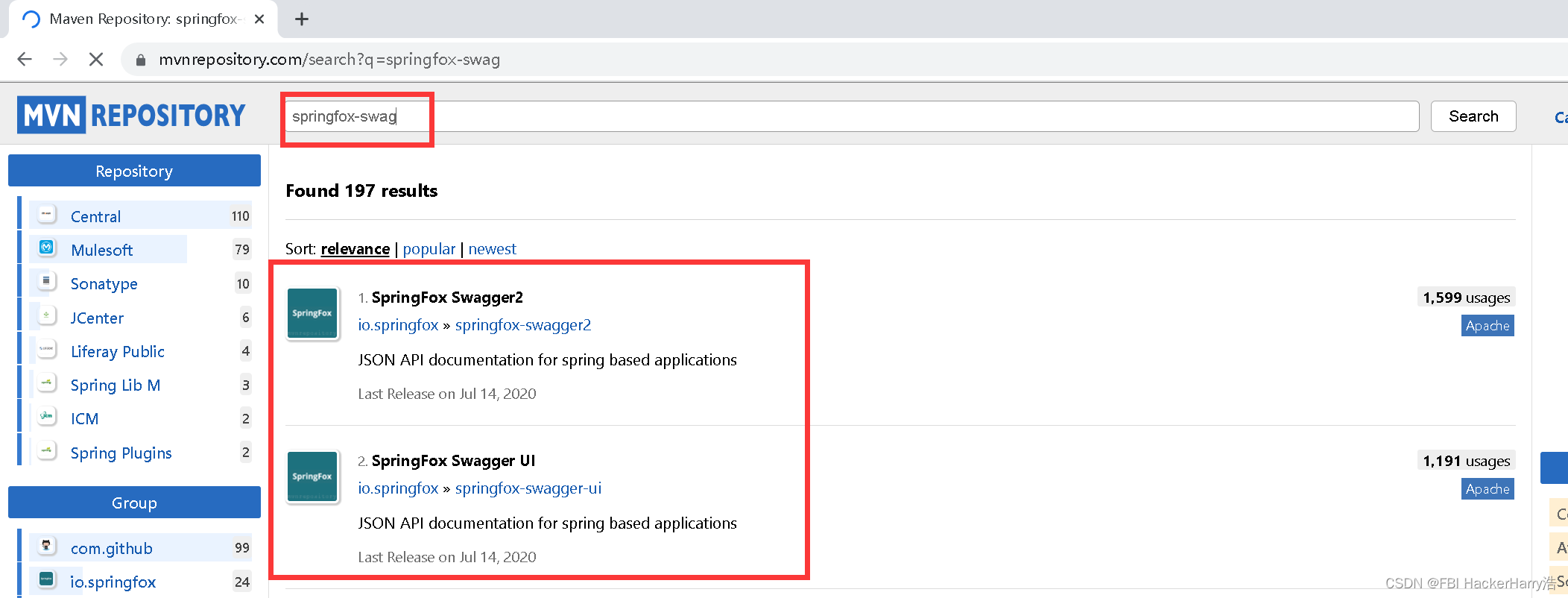
swagger2
<!-- https://mvnrepository.com/artifact/io.springfox/springfox-swagger2 -->
<dependency>
<groupId>io.springfox</groupId>
<artifactId>springfox-swagger2</artifactId>
<version>2.9.2</version>
</dependency>
swagger-ui
<!-- https://mvnrepository.com/artifact/io.springfox/springfox-swagger-ui -->
<dependency>
<groupId>io.springfox</groupId>
<artifactId>springfox-swagger-ui</artifactId>
<version>2.9.2</version>
</dependency>
3.3编写一个Hello工程

package com.kuang.swagger.controller;
import org.springframework.web.bind.annotation.RequestMapping;
import org.springframework.web.bind.annotation.RestController;
@RestController
public class HelloController {
// / /error
@RequestMapping(value = "/hello")
public String hello(){
return "hello";
}
}
3.4 配置Swagger==>Config
package com.kuang.swagger.config;
import org.springframework.context.annotation.Configuration;
import springfox.documentation.swagger2.annotations.EnableSwagger2;
@EnableSwagger2//开启Swagger2
@Configuration//等价于@Component
public class SwaggerConfig {
}
3.5.测试运行,访问http://localhost:8080/swagger-ui.html

swagger-ui.html来自于swagger-ui jar包下的resources目录下的swagger-ui.html
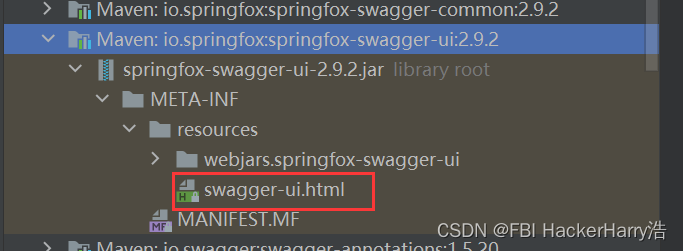
四、配置Swagger
Swagger的bean实例Docket;
new Docket()源码
第一层源码:new Docket()构造方法:

第二层源码:DocumentationType类
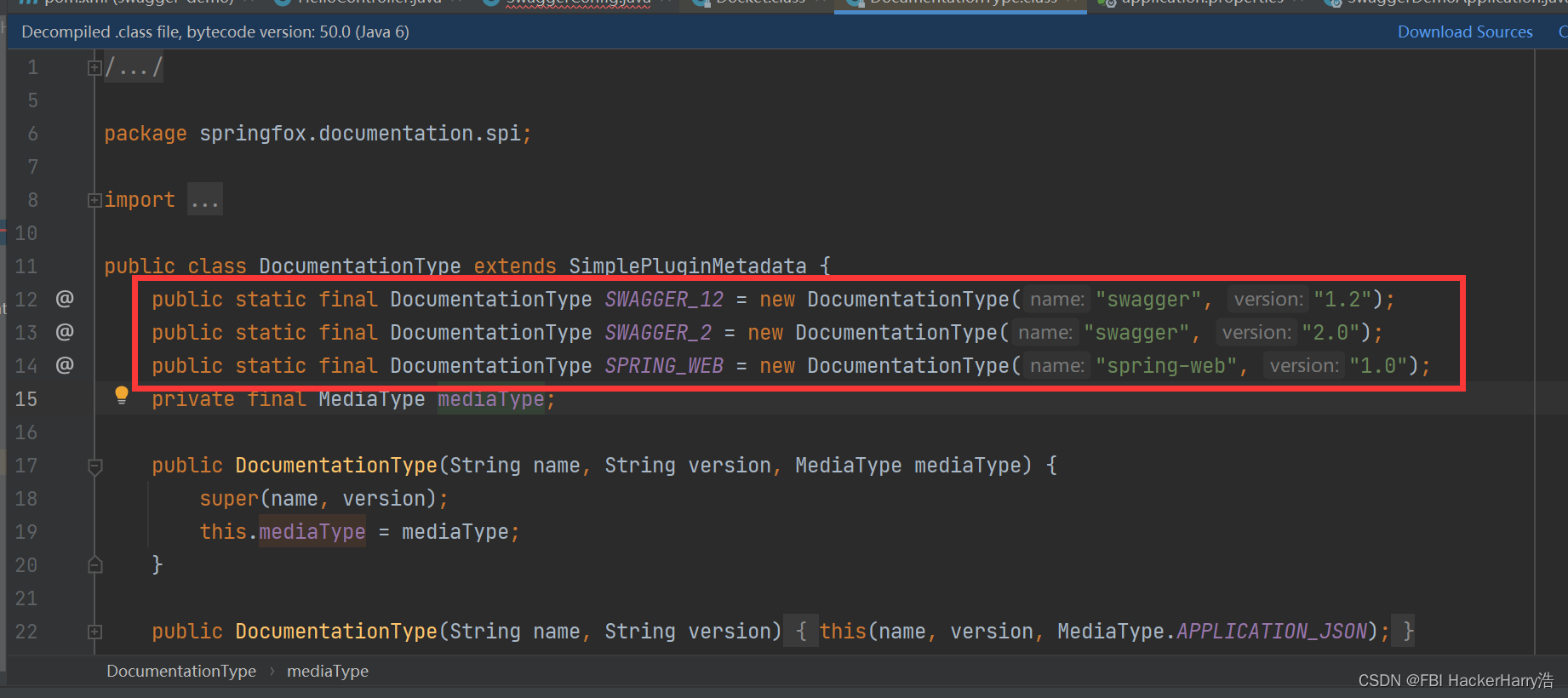
代码写到如下
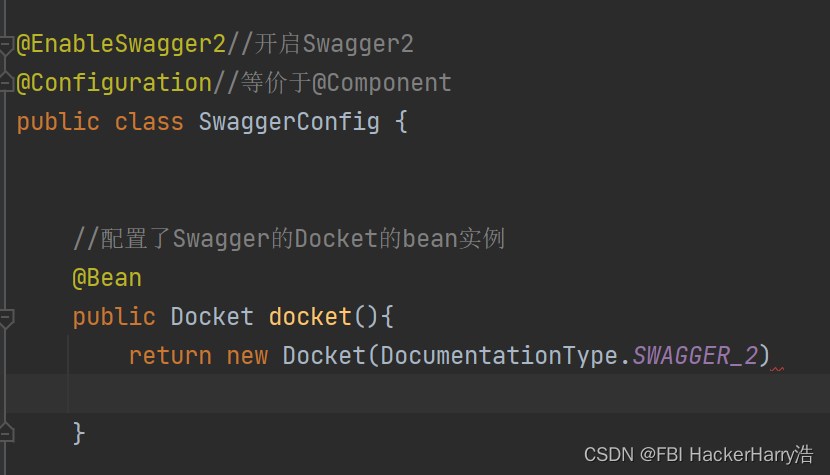
new Docket(DocumentationType.SWAGGER_2)
.apiInfo()
.apiInfo的源码
第一层源码:
.apiInfo的源码

第二层源码:
ApiInfo的源码
//
// Source code recreated from a .class file by IntelliJ IDEA
// (powered by FernFlower decompiler)
//
package springfox.documentation.service;
import com.google.common.collect.Lists;
import java.util.ArrayList;
import java.util.Collection;
import java.util.List;
public class ApiInfo {
public static final Contact DEFAULT_CONTACT = new Contact("", "", "");
public static final ApiInfo DEFAULT;
private final String version;
private final String title;
private final String description;
private final String termsOfServiceUrl;
private final String license;
private final String licenseUrl;
private final Contact contact;
private final List<VendorExtension> vendorExtensions;
/** @deprecated */
@Deprecated
public ApiInfo(String title, String description, String version, String termsOfServiceUrl, String contactName, String license, String licenseUrl) {
this(title, description, version, termsOfServiceUrl, new Contact(contactName, "", ""), license, licenseUrl, new ArrayList());
}
public ApiInfo(String title, String description, String version, String termsOfServiceUrl, Contact contact, String license, String licenseUrl, Collection<VendorExtension> vendorExtensions) {
this.title = title;
this.description = description;
this.version = version;
this.termsOfServiceUrl = termsOfServiceUrl;
this.contact = contact;
this.license = license;
this.licenseUrl = licenseUrl;
this.vendorExtensions = Lists.newArrayList(vendorExtensions);
}
public String getTitle() {
return this.title;
}
public String getDescription() {
return this.description;
}
public String getTermsOfServiceUrl() {
return this.termsOfServiceUrl;
}
public Contact getContact() {
return this.contact;
}
public String getLicense() {
return this.license;
}
public String getLicenseUrl() {
return this.licenseUrl;
}
public String getVersion() {
return this.version;
}
public List<VendorExtension> getVendorExtensions() {
return this.vendorExtensions;
}
static {
DEFAULT = new ApiInfo("Api Documentation", "Api Documentation", "1.0", "urn:tos", DEFAULT_CONTACT, "Apache 2.0", "http://www.apache.org/licenses/LICENSE-2.0", new ArrayList());
}
}
代码写到如下
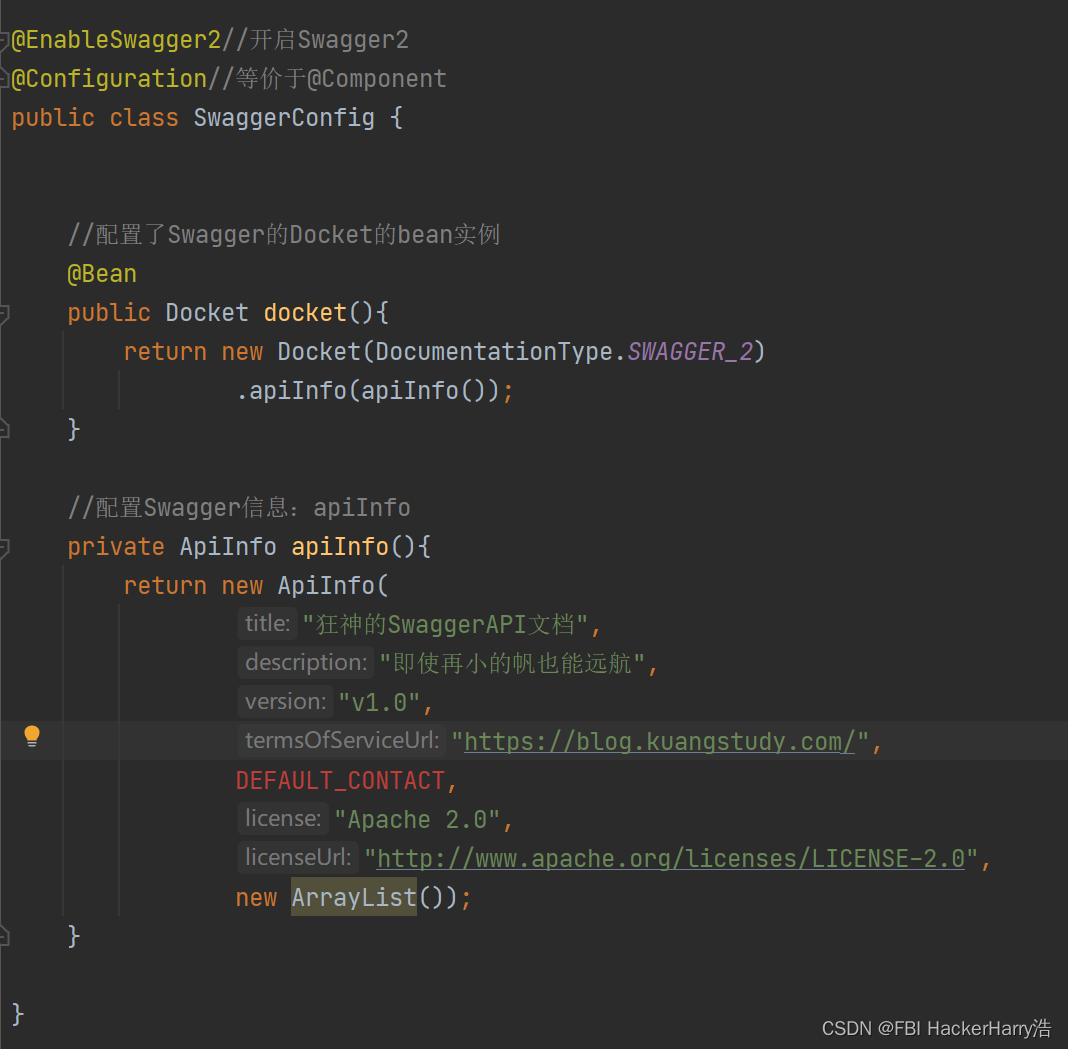
再看第二层源码:ApiInfo的源码,代码可写到如下
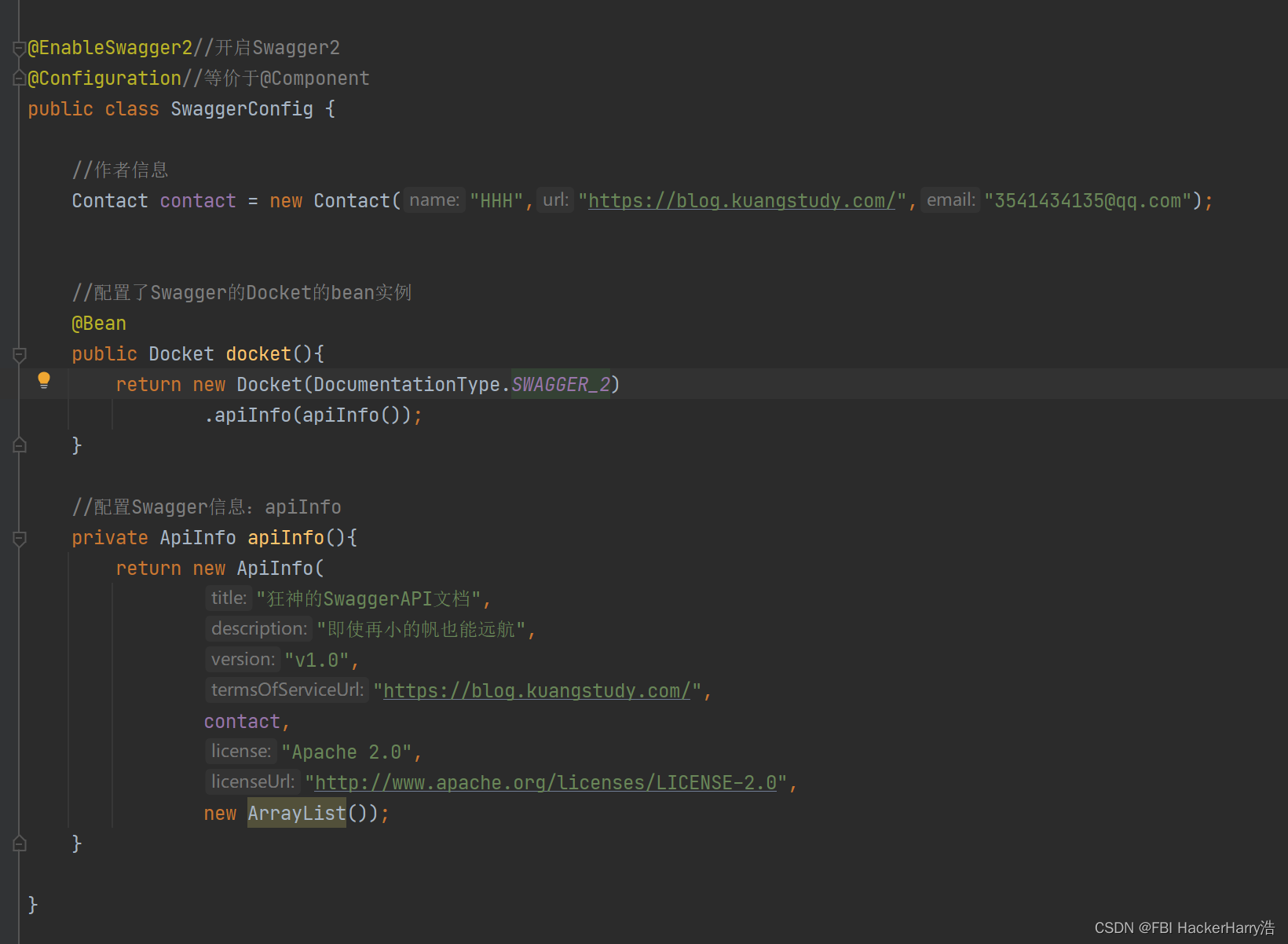
package com.kuang.swagger.config;
import org.springframework.context.annotation.Bean;
import org.springframework.context.annotation.Configuration;
import springfox.documentation.service.ApiInfo;
import springfox.documentation.service.Contact;
import springfox.documentation.spi.DocumentationType;
import springfox.documentation.spring.web.plugins.Docket;
import springfox.documentation.swagger2.annotations.EnableSwagger2;
import java.util.ArrayList;
@EnableSwagger2//开启Swagger2
@Configuration//等价于@Component
public class SwaggerConfig {
//作者信息
Contact contact = new Contact("HHH","https://blog.kuangstudy.com/","[email protected]");
//配置了Swagger的Docket的bean实例
@Bean
public Docket docket(){
return new Docket(DocumentationType.SWAGGER_2)
.apiInfo(apiInfo());
}
//配置Swagger信息:apiInfo
private ApiInfo apiInfo(){
return new ApiInfo(
"狂神的SwaggerAPI文档",
"即使再小的帆也能远航",
"v1.0",
"https://blog.kuangstudy.com/",
contact,
"Apache 2.0",
"http://www.apache.org/licenses/LICENSE-2.0",
new ArrayList());
}
}
重启启动类,浏览器访问:http://localhost:8080/swagger-ui.html
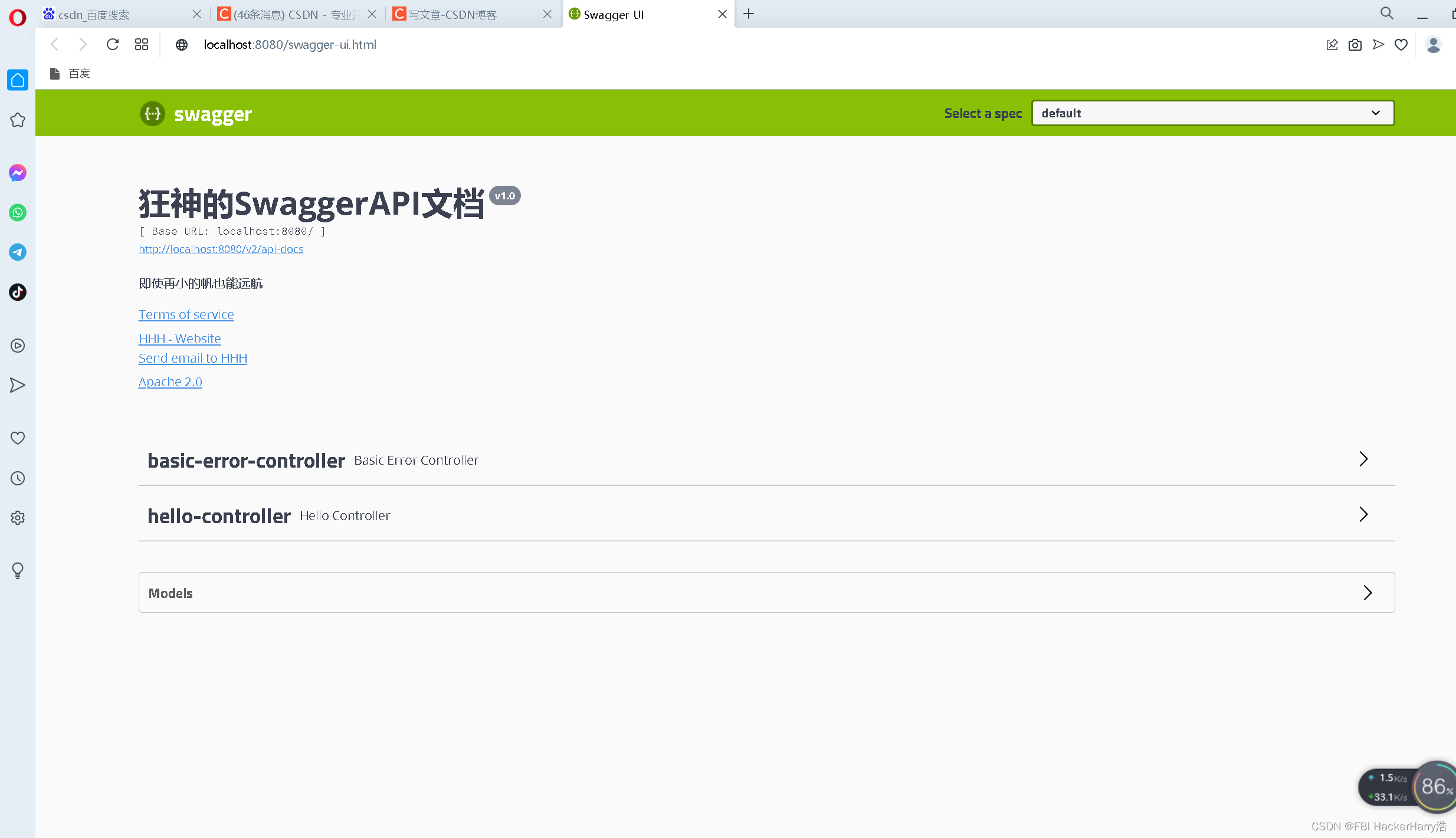
五、Swagger配置扫描接口
Docket.select()
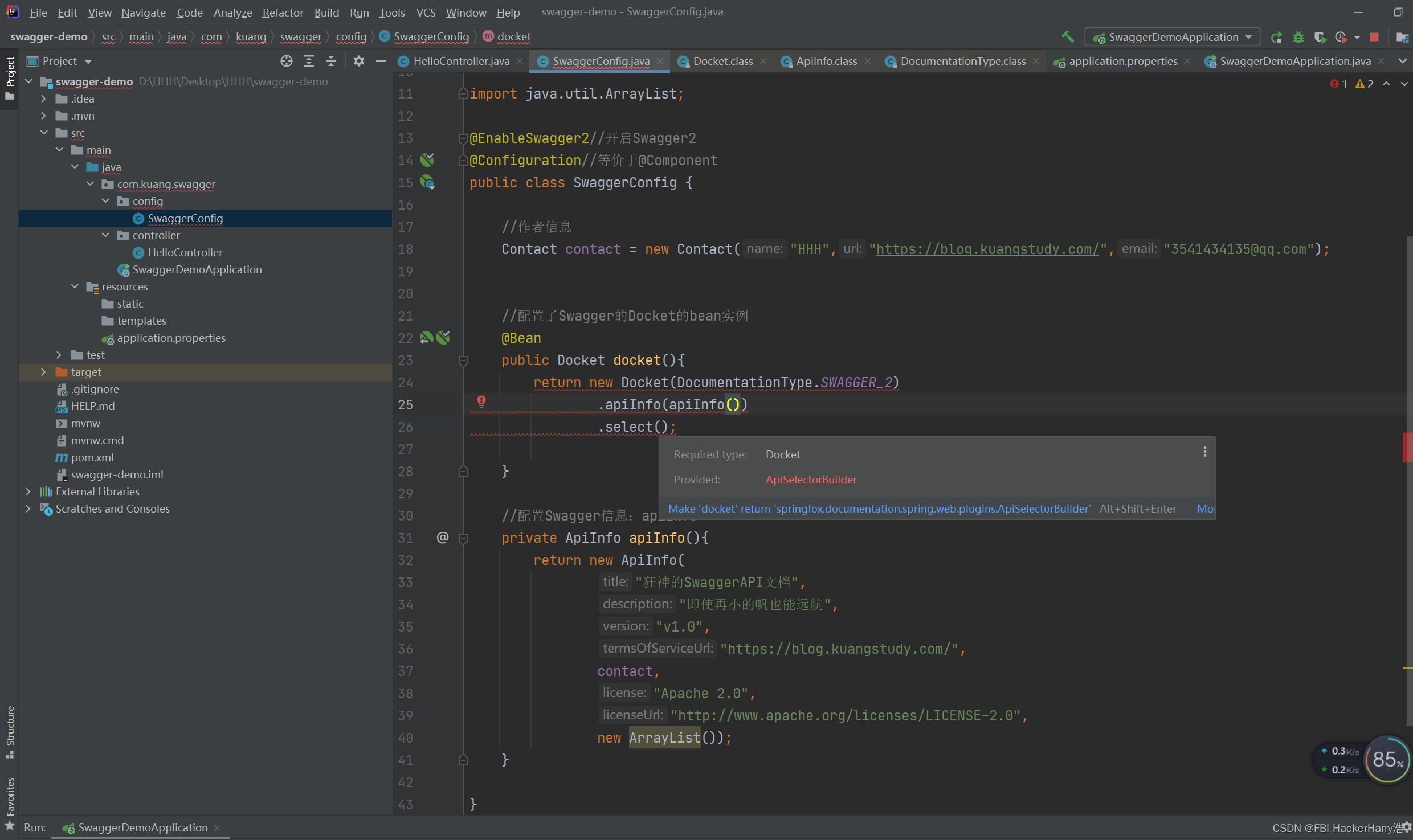
提供一个Builder

Docket.apis()源码

需要传selector
所以传入RequestHandlerSelectors
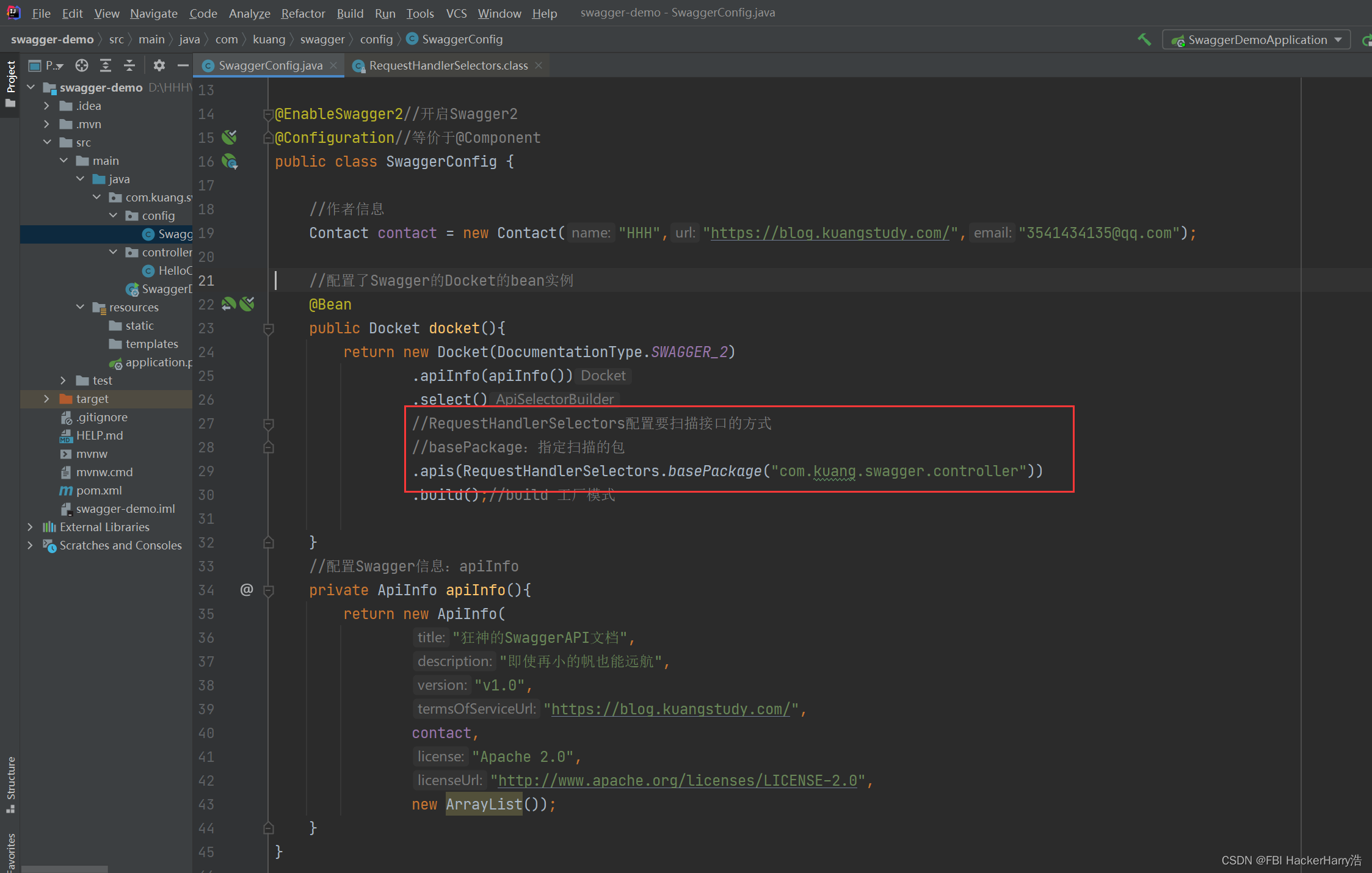
package com.kuang.swagger.config;
import org.springframework.context.annotation.Bean;
import org.springframework.context.annotation.Configuration;
import springfox.documentation.builders.RequestHandlerSelectors;
import springfox.documentation.service.ApiInfo;
import springfox.documentation.service.Contact;
import springfox.documentation.spi.DocumentationType;
import springfox.documentation.spring.web.plugins.Docket;
import springfox.documentation.swagger2.annotations.EnableSwagger2;
import java.util.ArrayList;
@EnableSwagger2//开启Swagger2
@Configuration//等价于@Component
public class SwaggerConfig {
//作者信息
Contact contact = new Contact("HHH","https://blog.kuangstudy.com/","[email protected]");
//配置了Swagger的Docket的bean实例
@Bean
public Docket docket(){
return new Docket(DocumentationType.SWAGGER_2)
.apiInfo(apiInfo())
.select()
//RequestHandlerSelectors配置要扫描接口的方式
//basePackage:指定扫描的包
.apis(RequestHandlerSelectors.basePackage("com.kuang.swagger.controller"))
.build();//build 工厂模式
}
//配置Swagger信息:apiInfo
private ApiInfo apiInfo(){
return new ApiInfo(
"狂神的SwaggerAPI文档",
"即使再小的帆也能远航",
"v1.0",
"https://blog.kuangstudy.com/",
contact,
"Apache 2.0",
"http://www.apache.org/licenses/LICENSE-2.0",
new ArrayList());
}
}
RequestHandlerSelectors源码如下
//
// Source code recreated from a .class file by IntelliJ IDEA
// (powered by FernFlower decompiler)
//
package springfox.documentation.builders;
import com.google.common.base.Function;
import com.google.common.base.Optional;
import com.google.common.base.Predicate;
import com.google.common.base.Predicates;
import java.lang.annotation.Annotation;
import org.springframework.util.ClassUtils;
import springfox.documentation.RequestHandler;
public class RequestHandlerSelectors {
private RequestHandlerSelectors() {
throw new UnsupportedOperationException();
}
public static Predicate<RequestHandler> any() {
return Predicates.alwaysTrue();
}
public static Predicate<RequestHandler> none() {
return Predicates.alwaysFalse();
}
public static Predicate<RequestHandler> withMethodAnnotation(final Class<? extends Annotation> annotation) {
return new Predicate<RequestHandler>() {
public boolean apply(RequestHandler input) {
return input.isAnnotatedWith(annotation);
}
};
}
public static Predicate<RequestHandler> withClassAnnotation(final Class<? extends Annotation> annotation) {
return new Predicate<RequestHandler>() {
public boolean apply(RequestHandler input) {
return (Boolean)RequestHandlerSelectors.declaringClass(input).transform(RequestHandlerSelectors.annotationPresent(annotation)).or(false);
}
};
}
private static Function<Class<?>, Boolean> annotationPresent(final Class<? extends Annotation> annotation) {
return new Function<Class<?>, Boolean>() {
public Boolean apply(Class<?> input) {
return input.isAnnotationPresent(annotation);
}
};
}
private static Function<Class<?>, Boolean> handlerPackage(final String basePackage) {
return new Function<Class<?>, Boolean>() {
public Boolean apply(Class<?> input) {
return ClassUtils.getPackageName(input).startsWith(basePackage);
}
};
}
public static Predicate<RequestHandler> basePackage(final String basePackage) {
return new Predicate<RequestHandler>() {
public boolean apply(RequestHandler input) {
return (Boolean)RequestHandlerSelectors.declaringClass(input).transform(RequestHandlerSelectors.handlerPackage(basePackage)).or(true);
}
};
}
private static Optional<? extends Class<?>> declaringClass(RequestHandler input) {
return Optional.fromNullable(input.declaringClass());
}
}
RequestHandlerSelectors配置要扫描接口的方式
| 方法 | 说明 | 实例 |
|---|---|---|
| basePackage | 指定扫描的包 | .basePackage(“com.kuang.swagger.controller”) |
| any | 扫描全部 | |
| none | 不扫描 | |
| withClassAnnotation(final Class<? extends Annotation> annotation) | 扫描类上的注解,参数是一个注解的反射对象 | .apis(RequestHandlerSelectors.withClassAnnotation(RestController.class)) |
| withMethodAnnotation(final Class<? extends Annotation> annotation) | 扫描方法上的注解 | .apis(RequestHandlerSelectors.withMethodAnnotation(GetMapping.class)) |
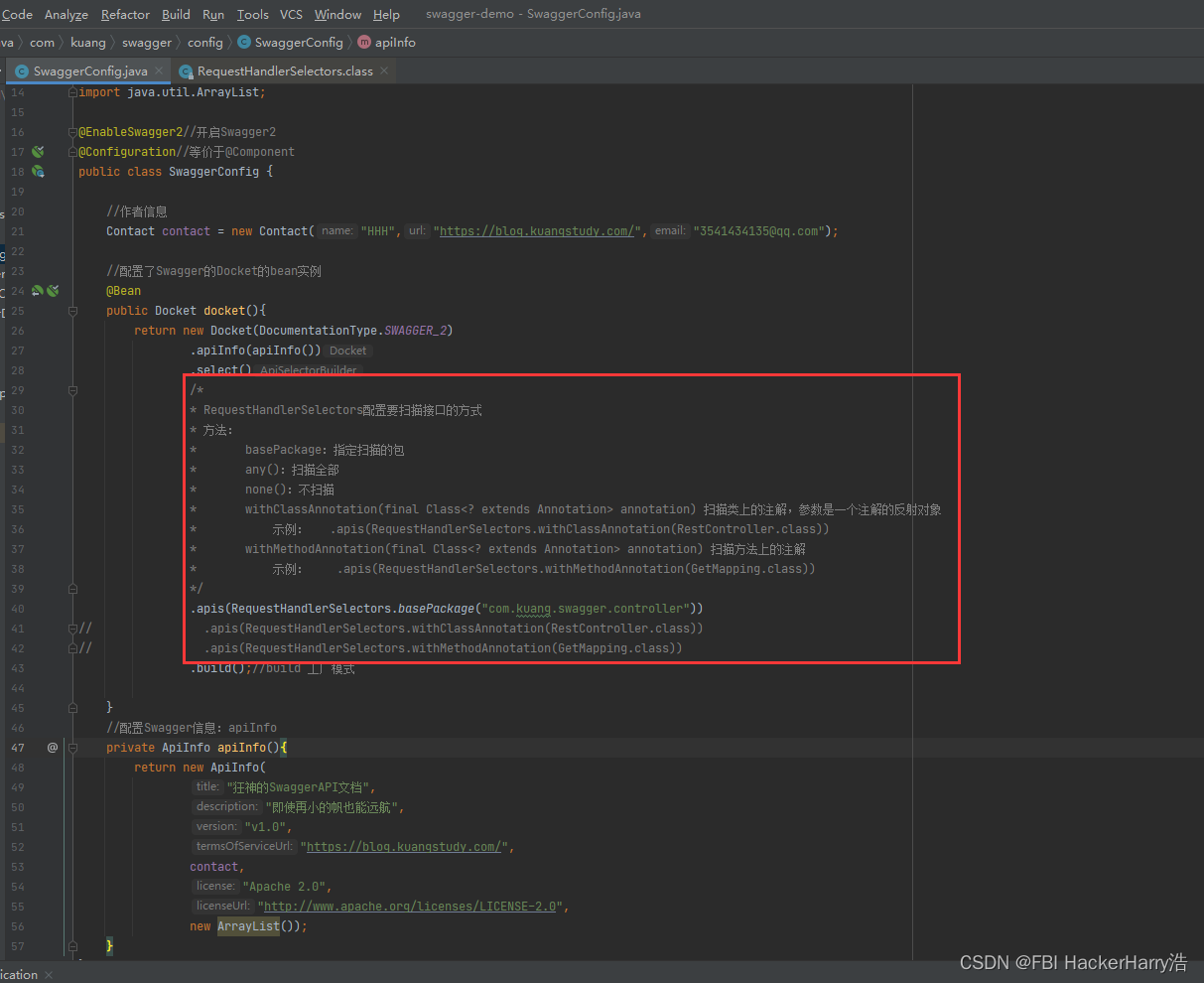
package com.kuang.swagger.config;
import org.springframework.context.annotation.Bean;
import org.springframework.context.annotation.Configuration;
import org.springframework.web.bind.annotation.GetMapping;
import org.springframework.web.bind.annotation.RestController;
import springfox.documentation.builders.RequestHandlerSelectors;
import springfox.documentation.service.ApiInfo;
import springfox.documentation.service.Contact;
import springfox.documentation.spi.DocumentationType;
import springfox.documentation.spring.web.plugins.Docket;
import springfox.documentation.swagger2.annotations.EnableSwagger2;
import java.util.ArrayList;
@EnableSwagger2//开启Swagger2
@Configuration//等价于@Component
public class SwaggerConfig {
//作者信息
Contact contact = new Contact("HHH","https://blog.kuangstudy.com/","[email protected]");
//配置了Swagger的Docket的bean实例
@Bean
public Docket docket(){
return new Docket(DocumentationType.SWAGGER_2)
.apiInfo(apiInfo())
.select()
/*
* RequestHandlerSelectors配置要扫描接口的方式
* 方法:
* basePackage:指定扫描的包
* any():扫描全部
* none():不扫描
* withClassAnnotation(final Class<? extends Annotation> annotation) 扫描类上的注解,参数是一个注解的反射对象
* 示例: .apis(RequestHandlerSelectors.withClassAnnotation(RestController.class))
* withMethodAnnotation(final Class<? extends Annotation> annotation) 扫描方法上的注解
* 示例: .apis(RequestHandlerSelectors.withMethodAnnotation(GetMapping.class))
*/
.apis(RequestHandlerSelectors.basePackage("com.kuang.swagger.controller"))
// .apis(RequestHandlerSelectors.withClassAnnotation(RestController.class))
// .apis(RequestHandlerSelectors.withMethodAnnotation(GetMapping.class))
.build();//build 工厂模式
}
//配置Swagger信息:apiInfo
private ApiInfo apiInfo(){
return new ApiInfo(
"狂神的SwaggerAPI文档",
"即使再小的帆也能远航",
"v1.0",
"https://blog.kuangstudy.com/",
contact,
"Apache 2.0",
"http://www.apache.org/licenses/LICENSE-2.0",
new ArrayList());
}
}
.paths()
//paths() 过滤什么路径
.paths(XXX)源代码
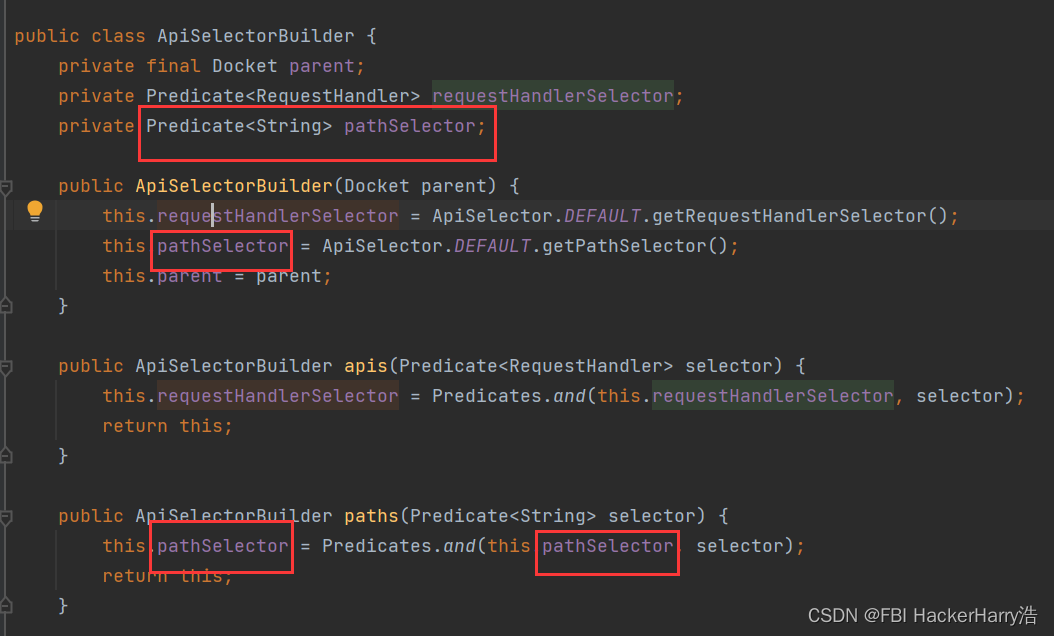
XXX需要传入一个PathSelector对象
PathSelectors.ant("/kuang/**")配置上这个就意味着扫描controller中方法的映射路径会多一层级,即扫描路径格式为:/kuang/XXX方法映射路径
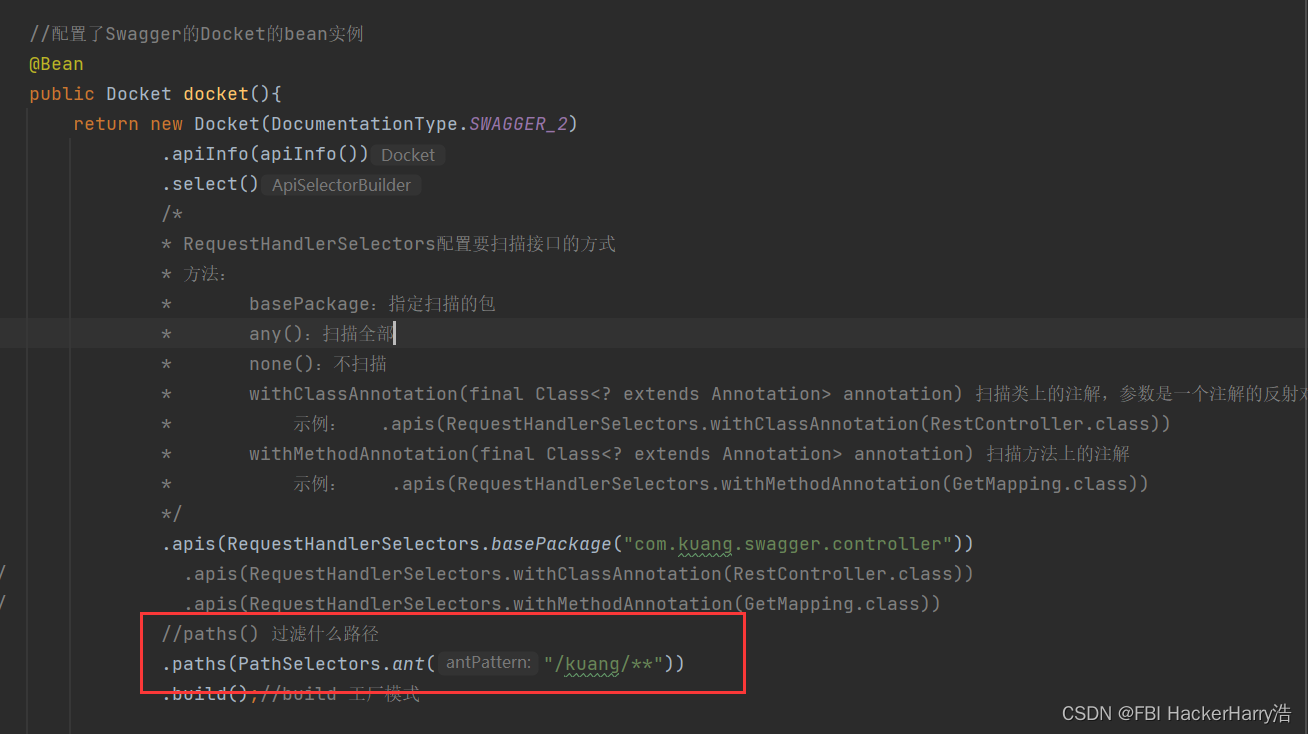
package com.kuang.swagger.config;
import org.springframework.context.annotation.Bean;
import org.springframework.context.annotation.Configuration;
import org.springframework.web.bind.annotation.GetMapping;
import org.springframework.web.bind.annotation.RestController;
import springfox.documentation.builders.PathSelectors;
import springfox.documentation.builders.RequestHandlerSelectors;
import springfox.documentation.service.ApiInfo;
import springfox.documentation.service.Contact;
import springfox.documentation.spi.DocumentationType;
import springfox.documentation.spring.web.plugins.Docket;
import springfox.documentation.swagger2.annotations.EnableSwagger2;
import java.util.ArrayList;
@EnableSwagger2//开启Swagger2
@Configuration//等价于@Component
public class SwaggerConfig {
//作者信息
Contact contact = new Contact("HHH","https://blog.kuangstudy.com/","[email protected]");
//配置了Swagger的Docket的bean实例
@Bean
public Docket docket(){
return new Docket(DocumentationType.SWAGGER_2)
.apiInfo(apiInfo())
.select()
/*
* RequestHandlerSelectors配置要扫描接口的方式
* 方法:
* basePackage:指定扫描的包
* any():扫描全部
* none():不扫描
* withClassAnnotation(final Class<? extends Annotation> annotation) 扫描类上的注解,参数是一个注解的反射对象
* 示例: .apis(RequestHandlerSelectors.withClassAnnotation(RestController.class))
* withMethodAnnotation(final Class<? extends Annotation> annotation) 扫描方法上的注解
* 示例: .apis(RequestHandlerSelectors.withMethodAnnotation(GetMapping.class))
*/
.apis(RequestHandlerSelectors.basePackage("com.kuang.swagger.controller"))
// .apis(RequestHandlerSelectors.withClassAnnotation(RestController.class))
// .apis(RequestHandlerSelectors.withMethodAnnotation(GetMapping.class))
//paths() 过滤什么路径
.paths(PathSelectors.ant("/kuang/**"))
.build();//build 工厂模式
}
//配置Swagger信息:apiInfo
private ApiInfo apiInfo(){
return new ApiInfo(
"狂神的SwaggerAPI文档",
"即使再小的帆也能远航",
"v1.0",
"https://blog.kuangstudy.com/",
contact,
"Apache 2.0",
"http://www.apache.org/licenses/LICENSE-2.0",
new ArrayList());
}
}
在HelloController.java中加上一个@RequestMapping("/kuang")

再次重启,浏览器访问 http://localhost:8080/swagger-ui.html
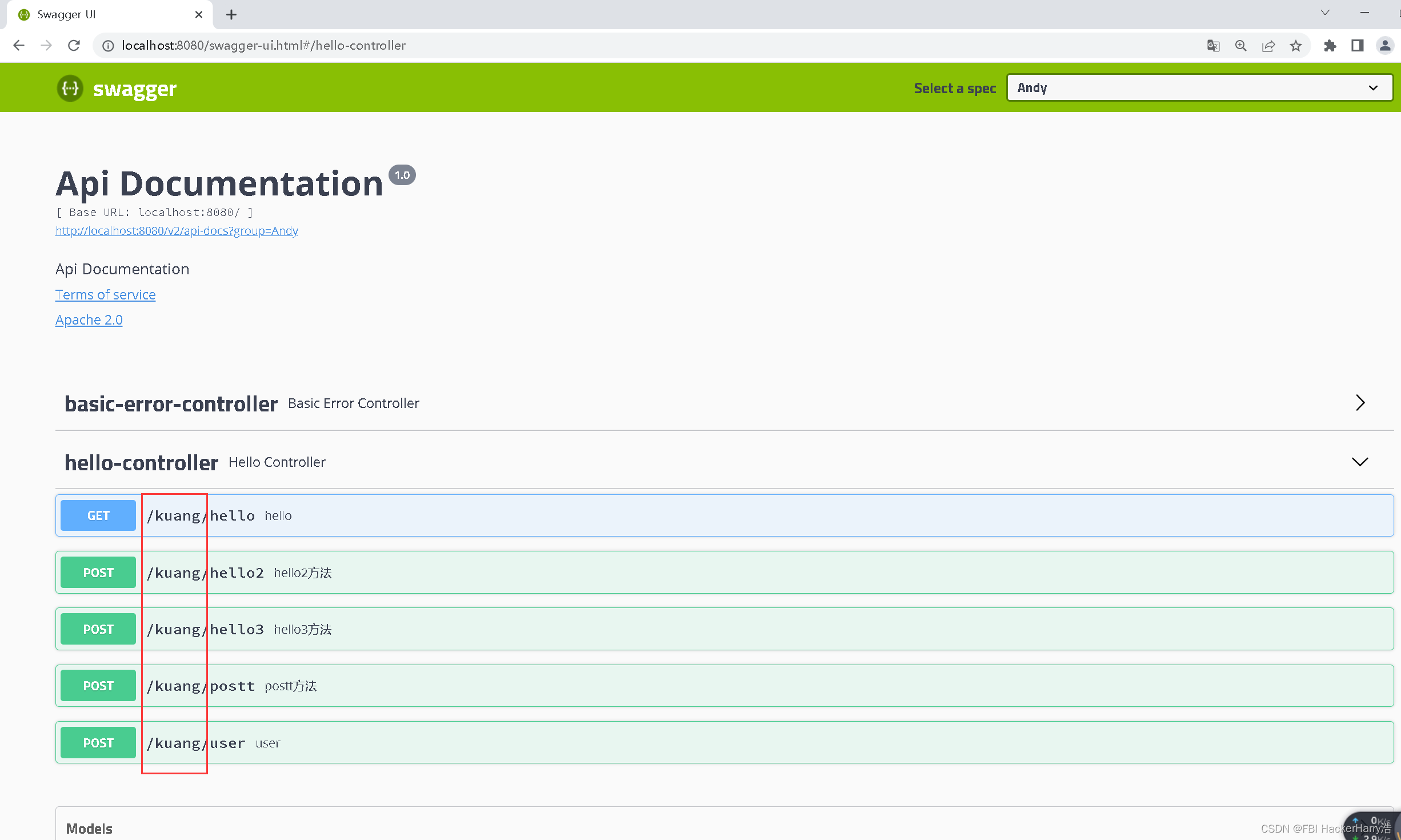
enable是否启动Swagger,如果为False,则Swagger不能再浏览器中访问
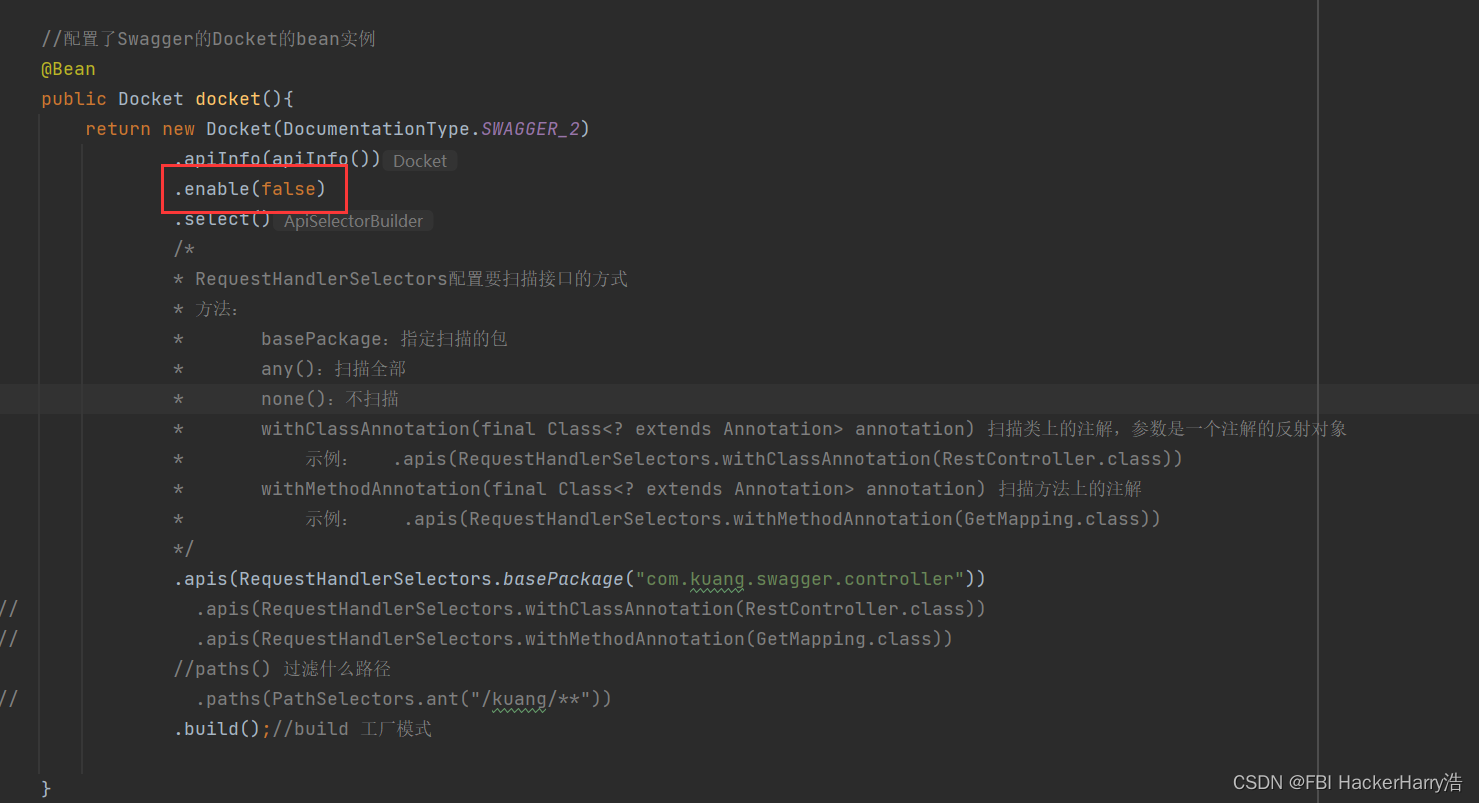
再次重启,浏览器访问 http://localhost:8080/swagger-ui.html
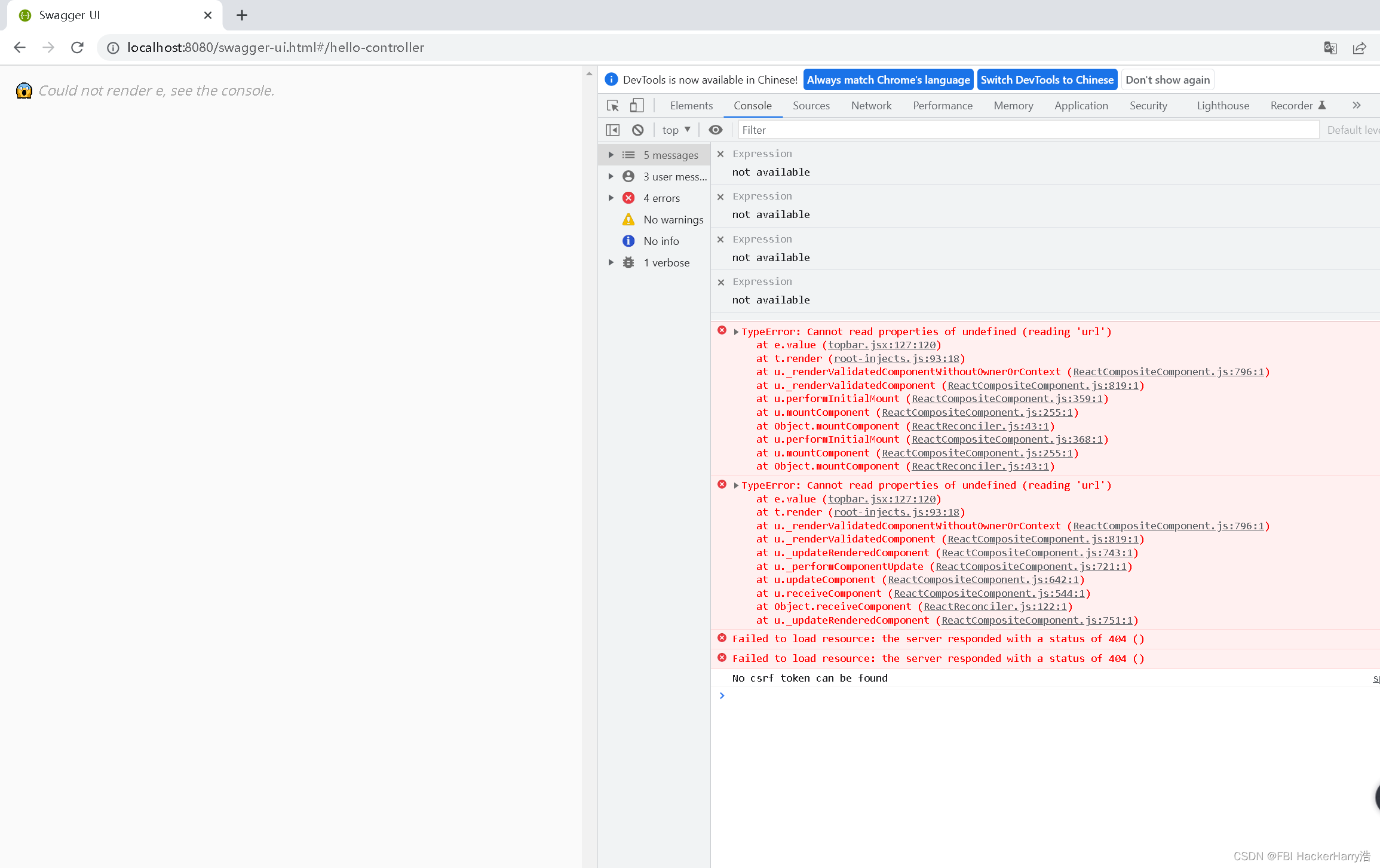
问题:我只希望我的Swagger在生产环境中使用,在发布的时候不使用,应该怎么办?
解决思路:
- 判断是不是生产环境 flag = false
- 注入 enable(flag)
案例实操
application.properties

spring.mvc.pathmatch.matching-strategy=ANT_PATH_MATCHER
spring.profiles.active=dev
application-dev.properties
application-pro.properties
application-test.properties
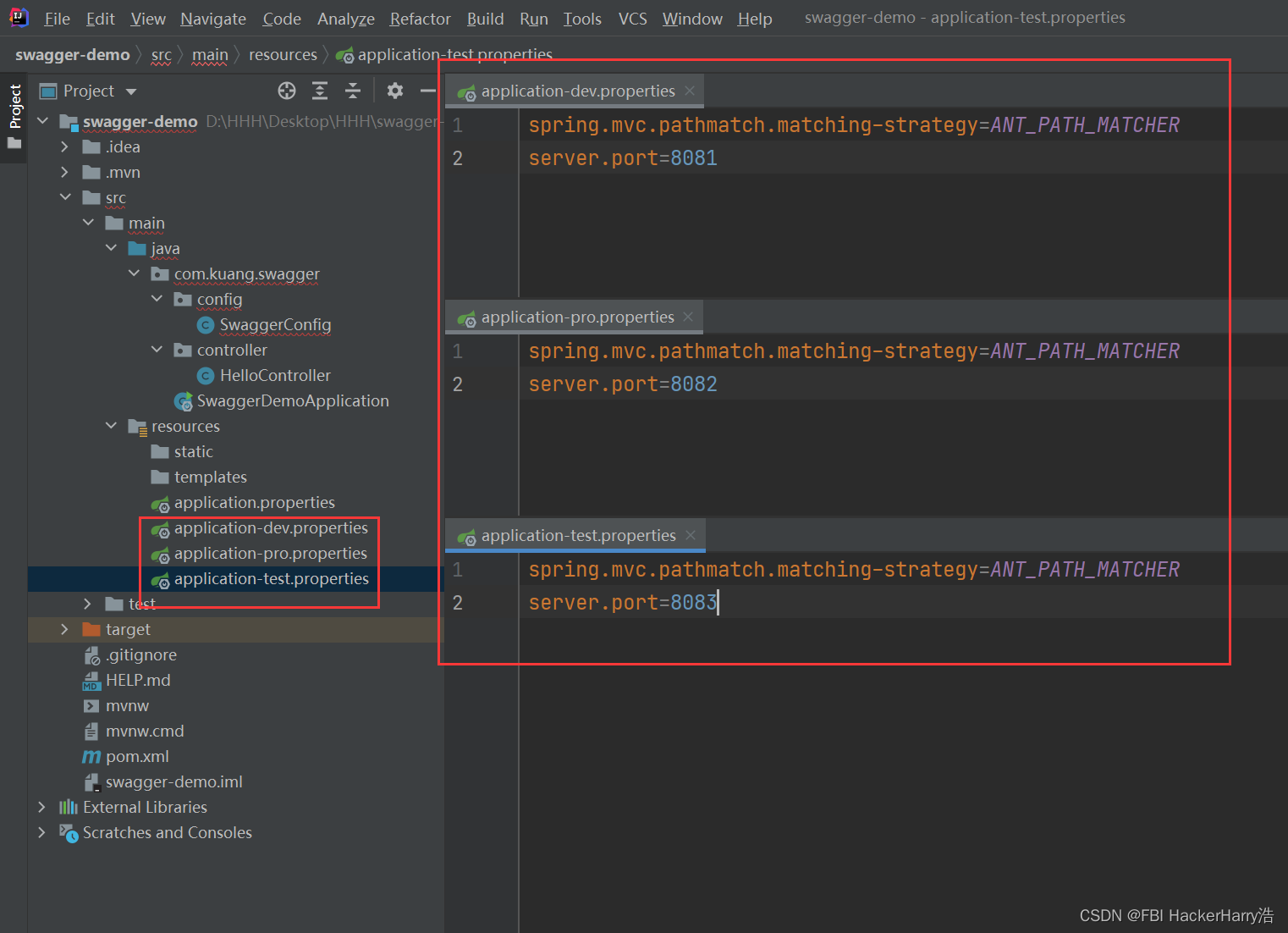
application-dev.properties
spring.mvc.pathmatch.matching-strategy=ANT_PATH_MATCHER
server.port=8081
application-pro.properties
spring.mvc.pathmatch.matching-strategy=ANT_PATH_MATCHER
server.port=8082
application-test.properties;
spring.mvc.pathmatch.matching-strategy=ANT_PATH_MATCHER
server.port=8083
引入2个类Environment类和Profiles类
①Environment类
org.springframework.core.env.Environment
Environment类源码如下:

②Profiles类
org.springframework.core.env.Profiles
Profiles类
源码如下:

SwaggerConfig配置类.java
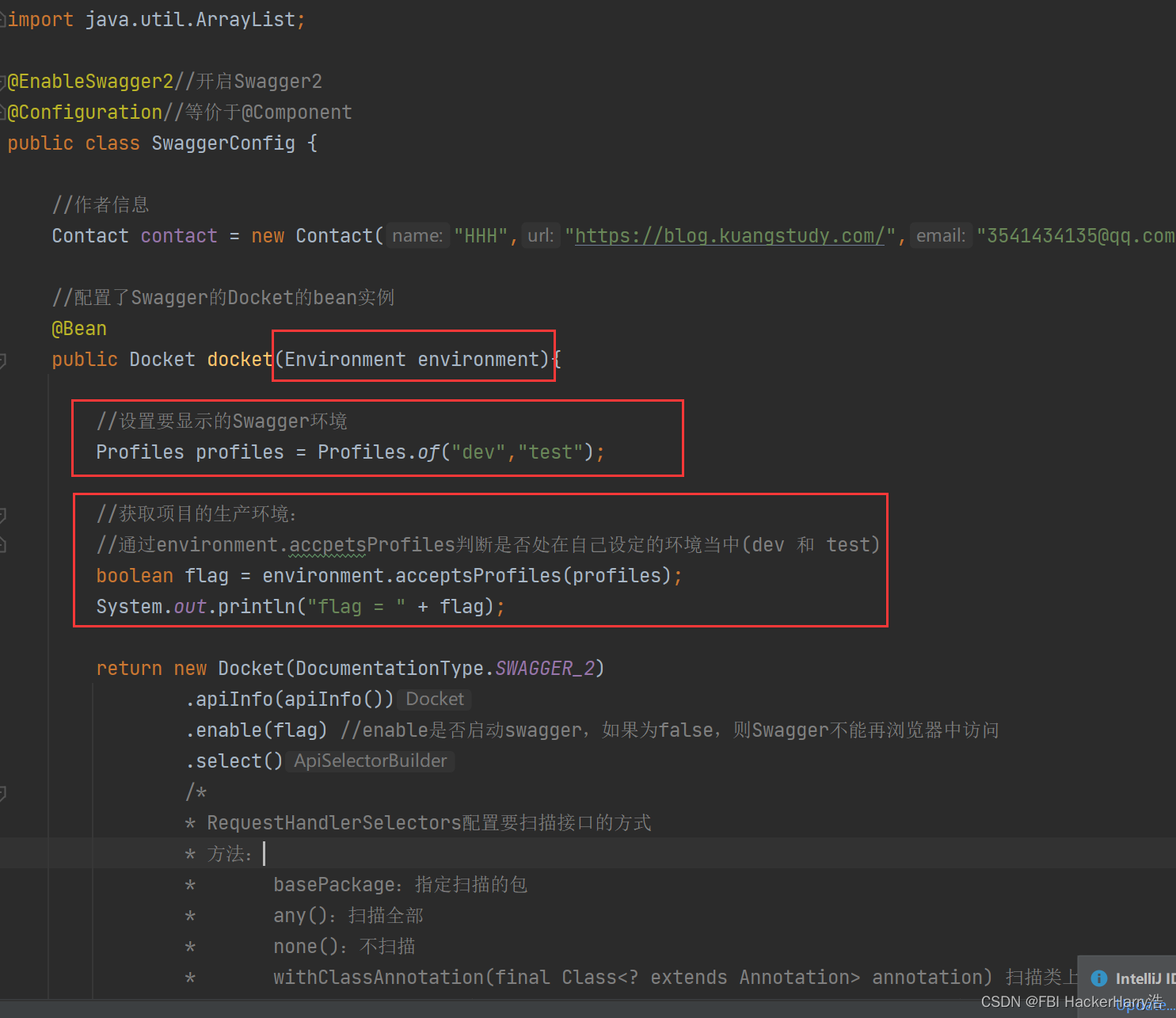
package com.kuang.swagger.config;
import org.springframework.context.annotation.Bean;
import org.springframework.context.annotation.Configuration;
import org.springframework.core.env.Environment;
import org.springframework.core.env.Profiles;
import org.springframework.web.bind.annotation.GetMapping;
import org.springframework.web.bind.annotation.RestController;
import springfox.documentation.builders.PathSelectors;
import springfox.documentation.builders.RequestHandlerSelectors;
import springfox.documentation.service.ApiInfo;
import springfox.documentation.service.Contact;
import springfox.documentation.spi.DocumentationType;
import springfox.documentation.spring.web.plugins.Docket;
import springfox.documentation.swagger2.annotations.EnableSwagger2;
import java.util.ArrayList;
@EnableSwagger2//开启Swagger2
@Configuration//等价于@Component
public class SwaggerConfig {
//作者信息
Contact contact = new Contact("HHH","https://blog.kuangstudy.com/","[email protected]");
//配置了Swagger的Docket的bean实例
@Bean
public Docket docket(Environment environment){
//设置要显示的Swagger环境
Profiles profiles = Profiles.of("dev","test");
//获取项目的生产环境:
//通过environment.accpetsProfiles判断是否处在自己设定的环境当中(dev 和 test)
boolean flag = environment.acceptsProfiles(profiles);
System.out.println("flag = " + flag);
return new Docket(DocumentationType.SWAGGER_2)
.apiInfo(apiInfo())
.enable(flag) //enable是否启动swagger,如果为false,则Swagger不能再浏览器中访问
.select()
/*
* RequestHandlerSelectors配置要扫描接口的方式
* 方法:
* basePackage:指定扫描的包
* any():扫描全部
* none():不扫描
* withClassAnnotation(final Class<? extends Annotation> annotation) 扫描类上的注解,参数是一个注解的反射对象
* 示例: .apis(RequestHandlerSelectors.withClassAnnotation(RestController.class))
* withMethodAnnotation(final Class<? extends Annotation> annotation) 扫描方法上的注解
* 示例: .apis(RequestHandlerSelectors.withMethodAnnotation(GetMapping.class))
*/
.apis(RequestHandlerSelectors.basePackage("com.kuang.swagger.controller"))
// .apis(RequestHandlerSelectors.withClassAnnotation(RestController.class))
// .apis(RequestHandlerSelectors.withMethodAnnotation(GetMapping.class))
//paths() 过滤什么路径
// .paths(PathSelectors.ant("/kuang/**"))
.build();//build 工厂模式
}
//配置Swagger信息:apiInfo
private ApiInfo apiInfo(){
return new ApiInfo(
"狂神的SwaggerAPI文档",
"即使再小的帆也能远航",
"v1.0",
"https://blog.kuangstudy.com/",
contact,
"Apache 2.0",
"http://www.apache.org/licenses/LICENSE-2.0",
new ArrayList());
}
}
此时application.properties为如下

启动启动类运行

flag = true
说明dev在Profiles里面,即在要显示的Swagger环境中
查看application-dev.properties

浏览器访问:http://localhost:8081/swagger-ui.html
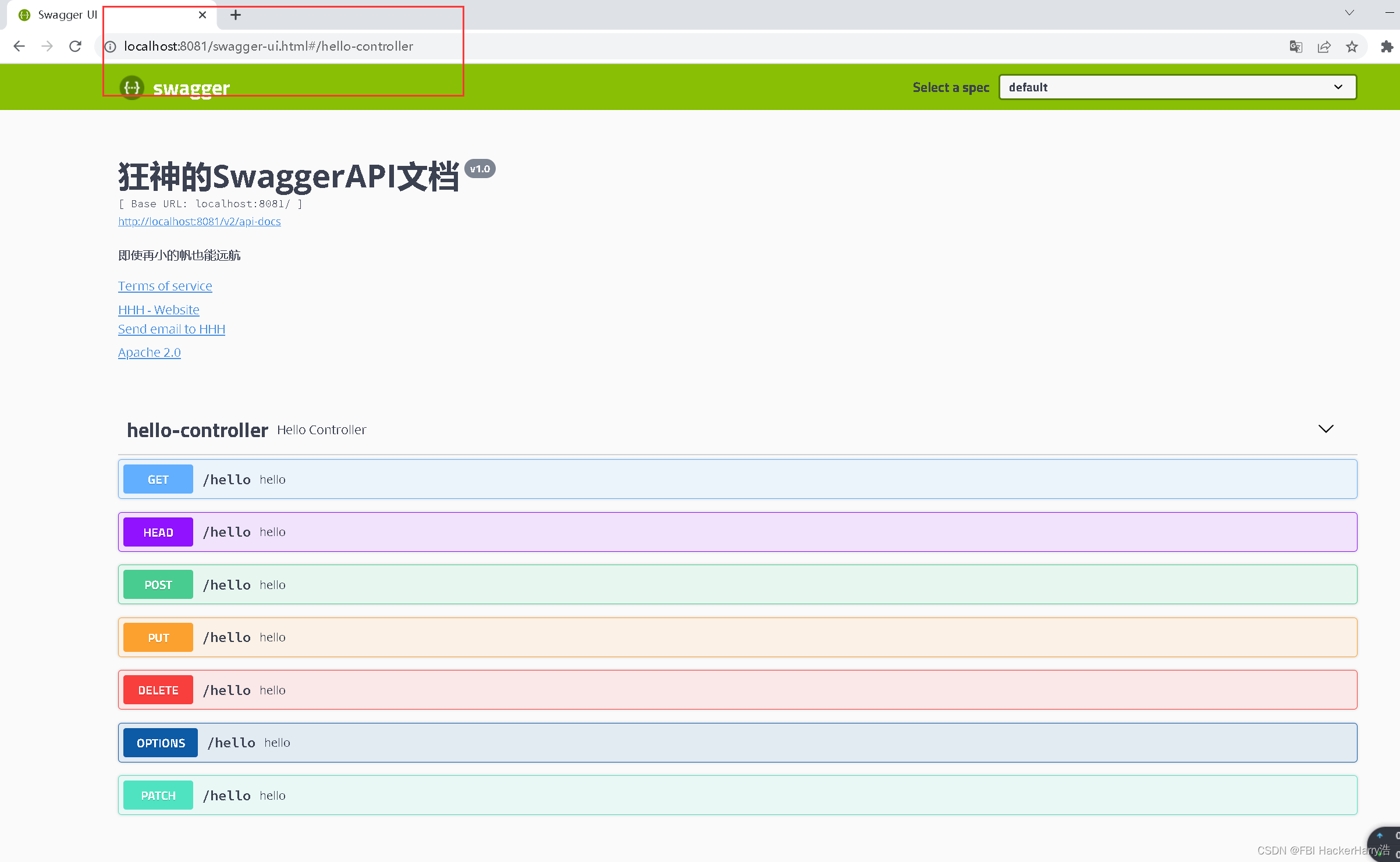
将application.properties切换为pro生产环境

启动启动类运行

flag = false
说明pro不在Profiles里面,即在不在要显示的Swagger环境中
查看application-pro.properties

浏览器访问:http://localhost:8082/swagger-ui.html
.
将application.properties切换为test测试环境

启动启动类运行
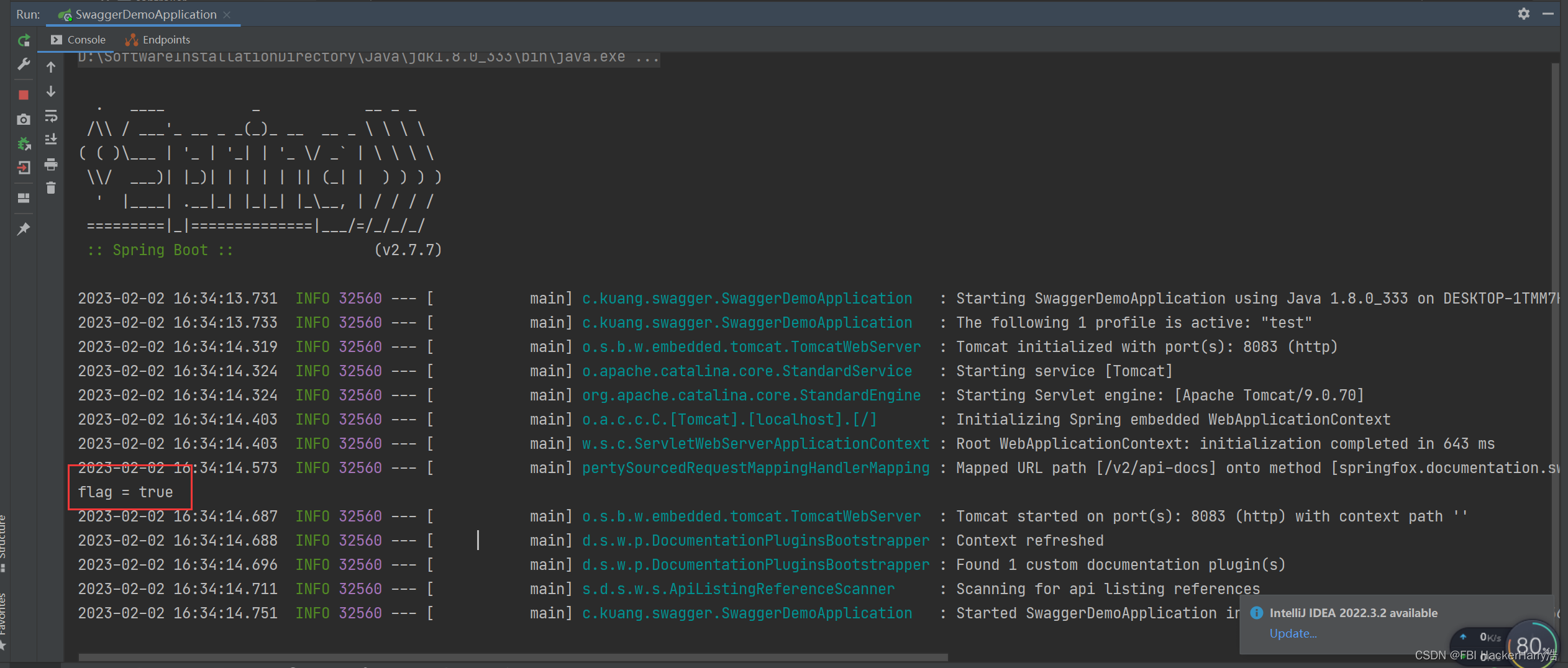
flag = true
说明test在Profiles里面,即在要显示的Swagger环境中
查看application-test.properties

浏览器访问:http://localhost:8083/swagger-ui.html

六、配置API文档的分组
application.properties先还原为dev开发环境

查看new Docket()的源码
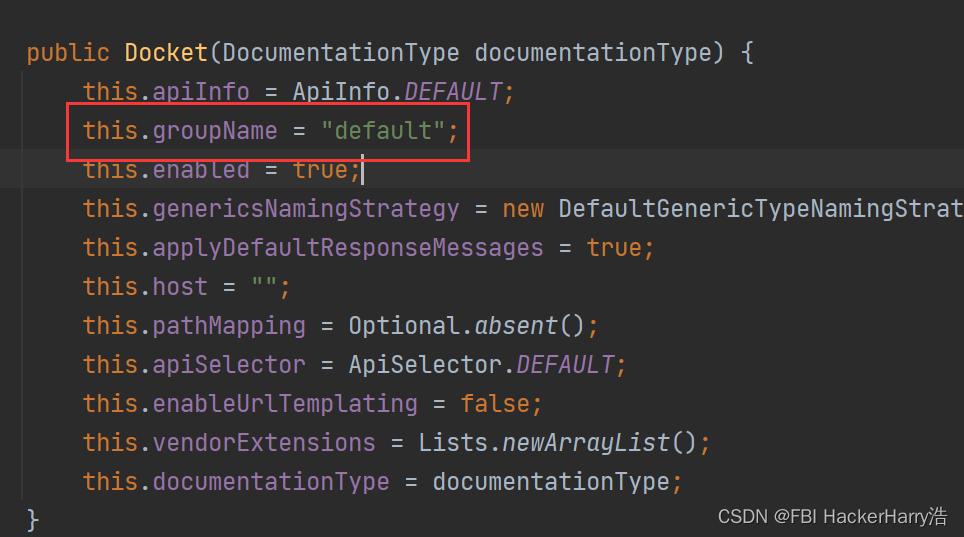
所以需要手动配置groupName
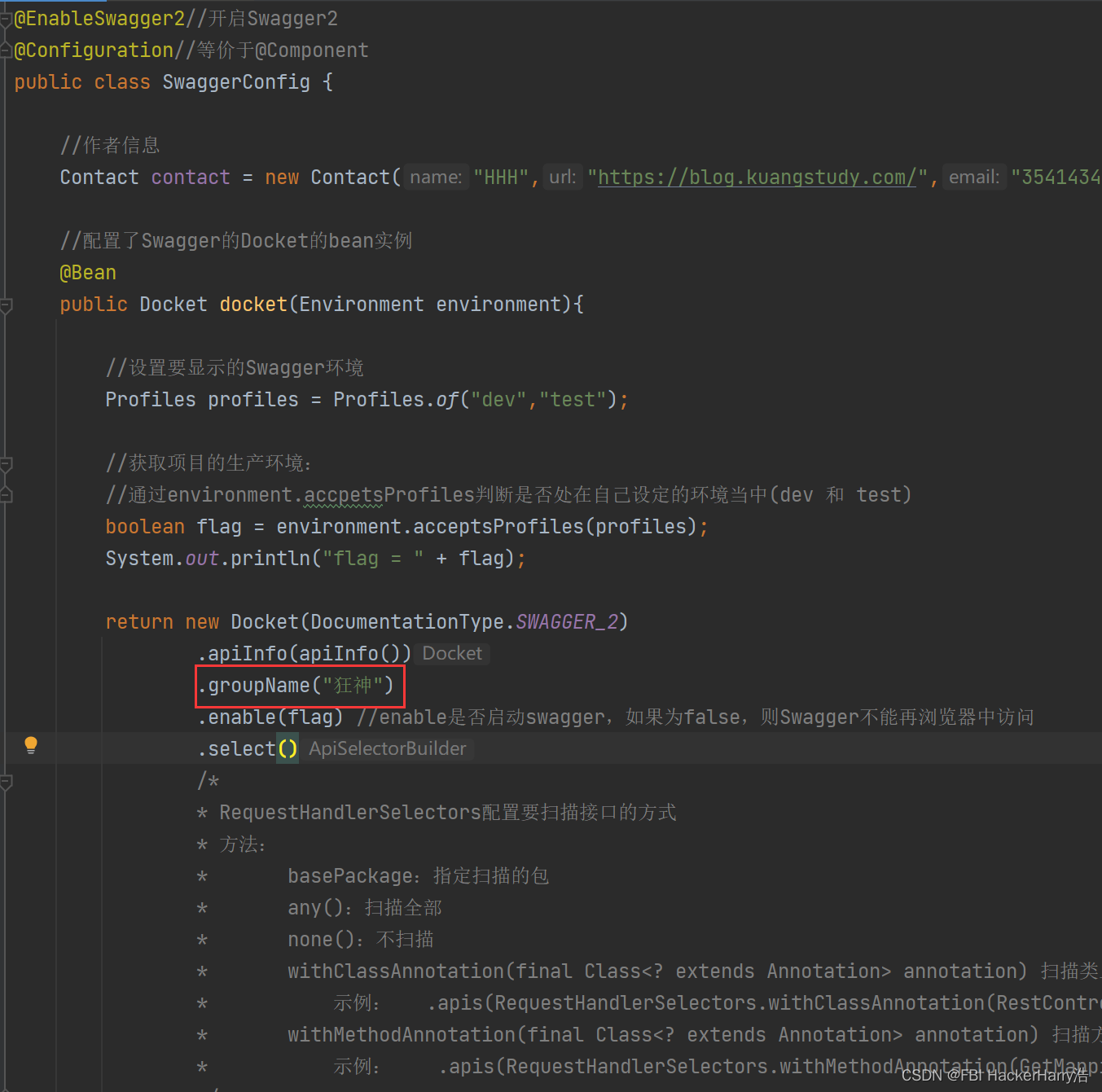
package com.kuang.swagger.config;
import org.springframework.context.annotation.Bean;
import org.springframework.context.annotation.Configuration;
import org.springframework.core.env.Environment;
import org.springframework.core.env.Profiles;
import org.springframework.web.bind.annotation.GetMapping;
import org.springframework.web.bind.annotation.RestController;
import springfox.documentation.builders.PathSelectors;
import springfox.documentation.builders.RequestHandlerSelectors;
import springfox.documentation.service.ApiInfo;
import springfox.documentation.service.Contact;
import springfox.documentation.spi.DocumentationType;
import springfox.documentation.spring.web.plugins.Docket;
import springfox.documentation.swagger2.annotations.EnableSwagger2;
import java.util.ArrayList;
//开启Swagger2
//等价于@Component
public class SwaggerConfig {
//作者信息
Contact contact = new Contact("HHH","https://blog.kuangstudy.com/","[email protected]");
//配置了Swagger的Docket的bean实例
public Docket docket(Environment environment){
//设置要显示的Swagger环境
Profiles profiles = Profiles.of("dev","test");
//获取项目的生产环境:
//通过environment.accpetsProfiles判断是否处在自己设定的环境当中(dev 和 test)
boolean flag = environment.acceptsProfiles(profiles);
System.out.println("flag = " + flag);
return new Docket(DocumentationType.SWAGGER_2)
.apiInfo(apiInfo())
.groupName("狂神")
.enable(flag) //enable是否启动swagger,如果为false,则Swagger不能再浏览器中访问
.select()
/*
* RequestHandlerSelectors配置要扫描接口的方式
* 方法:
* basePackage:指定扫描的包
* any():扫描全部
* none():不扫描
* withClassAnnotation(final Class<? extends Annotation> annotation) 扫描类上的注解,参数是一个注解的反射对象
* 示例: .apis(RequestHandlerSelectors.withClassAnnotation(RestController.class))
* withMethodAnnotation(final Class<? extends Annotation> annotation) 扫描方法上的注解
* 示例: .apis(RequestHandlerSelectors.withMethodAnnotation(GetMapping.class))
*/
.apis(RequestHandlerSelectors.basePackage("com.kuang.swagger.controller"))
// .apis(RequestHandlerSelectors.withClassAnnotation(RestController.class))
// .apis(RequestHandlerSelectors.withMethodAnnotation(GetMapping.class))
//paths() 过滤什么路径
// .paths(PathSelectors.ant("/kuang/**"))
.build();//build 工厂模式
}
//配置Swagger信息:apiInfo
private ApiInfo apiInfo(){
return new ApiInfo(
"狂神的SwaggerAPI文档",
"即使再小的帆也能远航",
"v1.0",
"https://blog.kuangstudy.com/",
contact,
"Apache 2.0",
"http://www.apache.org/licenses/LICENSE-2.0",
new ArrayList());
}
}
浏览器访问:http://localhost:8081/swagger-ui.html
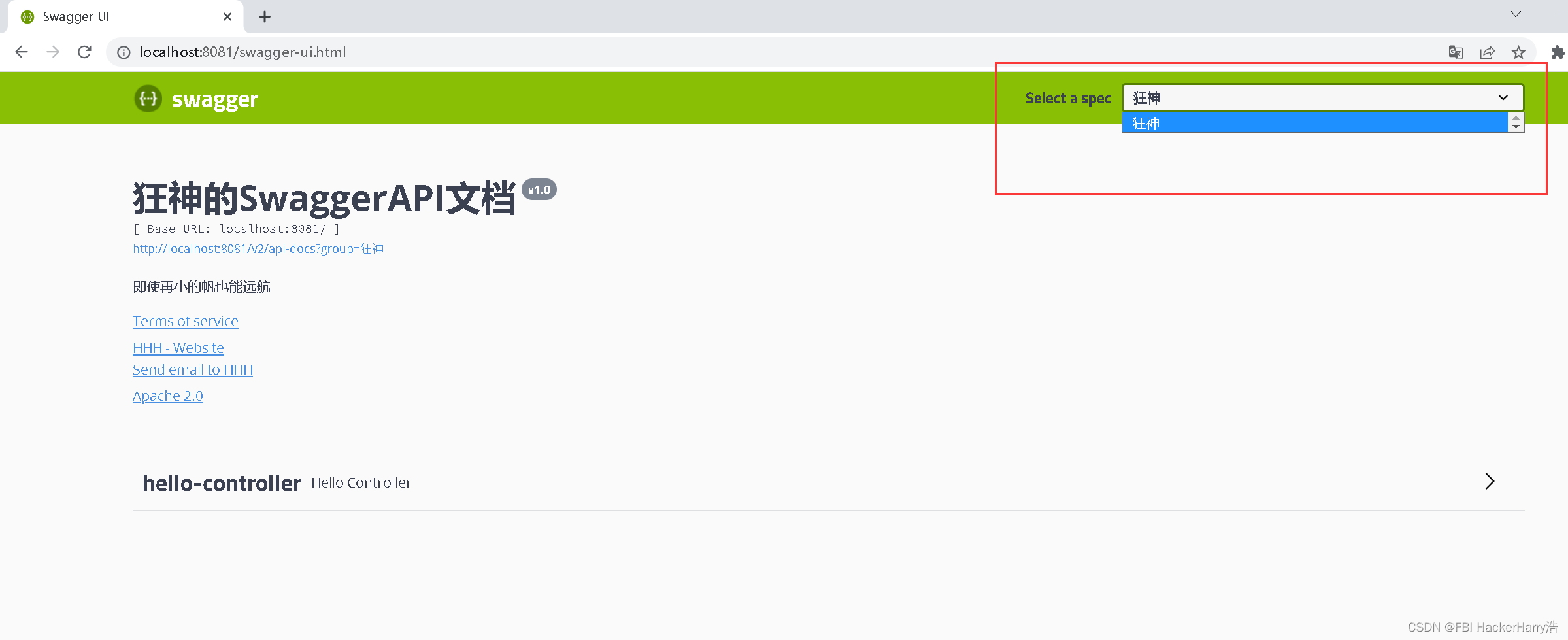
问题:如何配置多个分组?
解答:配置多个Docket实例即可

SwaggerConfig.java配置类
package com.kuang.swagger.config;
import org.springframework.context.annotation.Bean;
import org.springframework.context.annotation.Configuration;
import org.springframework.core.env.Environment;
import org.springframework.core.env.Profiles;
import org.springframework.web.bind.annotation.GetMapping;
import org.springframework.web.bind.annotation.RestController;
import springfox.documentation.builders.PathSelectors;
import springfox.documentation.builders.RequestHandlerSelectors;
import springfox.documentation.service.ApiInfo;
import springfox.documentation.service.Contact;
import springfox.documentation.spi.DocumentationType;
import springfox.documentation.spring.web.plugins.Docket;
import springfox.documentation.swagger2.annotations.EnableSwagger2;
import java.util.ArrayList;
//开启Swagger2
//等价于@Component
public class SwaggerConfig {
public Docket docketByAndy(){
return new Docket(DocumentationType.SWAGGER_2).groupName("Andy");
}
public Docket docketByBob(){
return new Docket(DocumentationType.SWAGGER_2).groupName("Bob");
}
public Docket docketByHHH(){
return new Docket(DocumentationType.SWAGGER_2).groupName("HHH");
}
//作者信息
Contact contact = new Contact("HHH","https://blog.kuangstudy.com/","[email protected]");
//配置了Swagger的Docket的bean实例
public Docket docket(Environment environment){
//设置要显示的Swagger环境
Profiles profiles = Profiles.of("dev","test");
//获取项目的生产环境:
//通过environment.accpetsProfiles判断是否处在自己设定的环境当中(dev 和 test)
boolean flag = environment.acceptsProfiles(profiles);
System.out.println("flag = " + flag);
return new Docket(DocumentationType.SWAGGER_2)
.apiInfo(apiInfo())
.groupName("狂神")
.enable(flag) //enable是否启动swagger,如果为false,则Swagger不能再浏览器中访问
.select()
/*
* RequestHandlerSelectors配置要扫描接口的方式
* 方法:
* basePackage:指定扫描的包
* any():扫描全部
* none():不扫描
* withClassAnnotation(final Class<? extends Annotation> annotation) 扫描类上的注解,参数是一个注解的反射对象
* 示例: .apis(RequestHandlerSelectors.withClassAnnotation(RestController.class))
* withMethodAnnotation(final Class<? extends Annotation> annotation) 扫描方法上的注解
* 示例: .apis(RequestHandlerSelectors.withMethodAnnotation(GetMapping.class))
*/
.apis(RequestHandlerSelectors.basePackage("com.kuang.swagger.controller"))
// .apis(RequestHandlerSelectors.withClassAnnotation(RestController.class))
// .apis(RequestHandlerSelectors.withMethodAnnotation(GetMapping.class))
//paths() 过滤什么路径
// .paths(PathSelectors.ant("/kuang/**"))
.build();//build 工厂模式
}
//配置Swagger信息:apiInfo
private ApiInfo apiInfo(){
return new ApiInfo(
"狂神的SwaggerAPI文档",
"即使再小的帆也能远航",
"v1.0",
"https://blog.kuangstudy.com/",
contact,
"Apache 2.0",
"http://www.apache.org/licenses/LICENSE-2.0",
new ArrayList());
}
}
浏览器访问: http://localhost:8081/swagger-ui.html
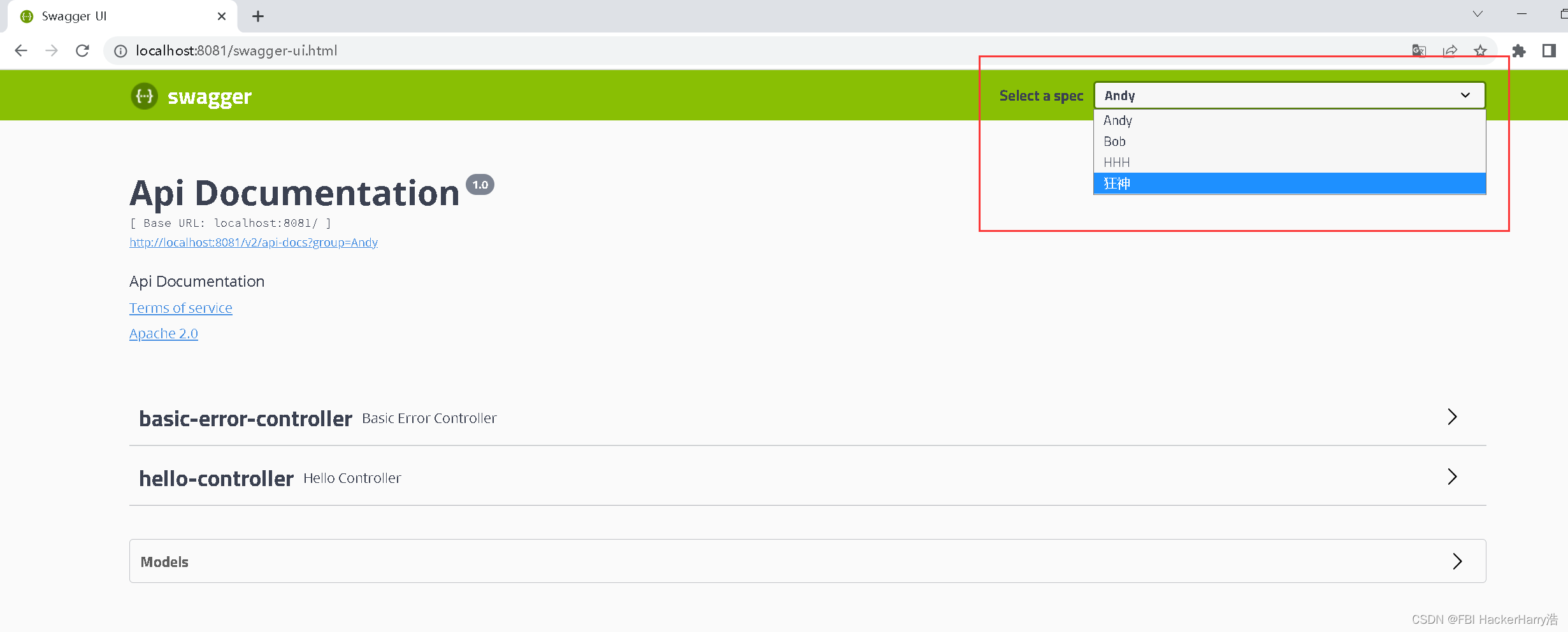
七、实体类配置
0.导入lombok依赖
<!-- https://mvnrepository.com/artifact/org.projectlombok/lombok -->
<dependency>
<groupId>org.projectlombok</groupId>
<artifactId>lombok</artifactId>
<version>1.18.24</version>
<scope>provided</scope>
</dependency>
1、新建一个实体类
com.kuang.swagger.pojo
User,java
package com.kuang.swagger.pojo;
import lombok.Data;
public class User {
private String username;
private String password;
}
只要我们的接口中,返回值中存在实体类,他就会被扫描到Swagger中
2.修改Controller层
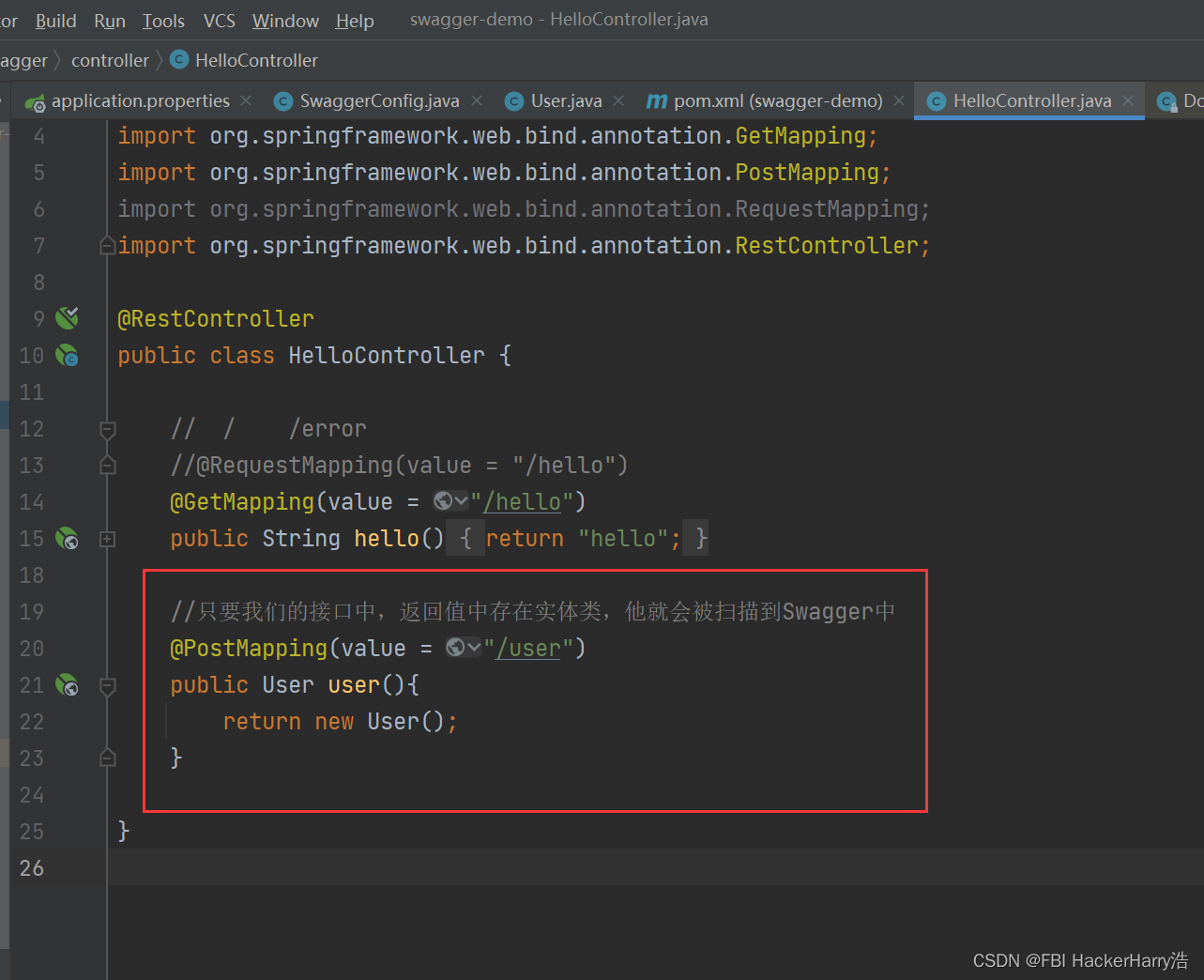
HelloController.java
package com.kuang.swagger.controller;
import com.kuang.swagger.pojo.User;
import org.springframework.web.bind.annotation.GetMapping;
import org.springframework.web.bind.annotation.PostMapping;
import org.springframework.web.bind.annotation.RequestMapping;
import org.springframework.web.bind.annotation.RestController;
public class HelloController {
// / /error
//@RequestMapping(value = "/hello")
(value = "/hello")
public String hello(){
return "hello";
}
//只要我们的接口中,返回值中存在实体类,他就会被扫描到Swagger中
(value = "/user")
public User user(){
return new User();
}
}
运行启动类,浏览器访问:http://localhost:8081/swagger-ui.html

@ApiModel(“XXX实体类”) 加在实体类上
@ApiModelProperty(“XXX成员变量”) 加在实体类的成员变量(属性)上

package com.kuang.swagger.pojo;
import io.swagger.annotations.Api;
import io.swagger.annotations.ApiModel;
import io.swagger.annotations.ApiModelProperty;
import lombok.Data;
("用户实体类")//给实体类加的一个文档注释
public class User {
("用户名")
private String username;
("密码")
private String password;
}
浏览器启动访问:http://localhost:8081/swagger-ui.html
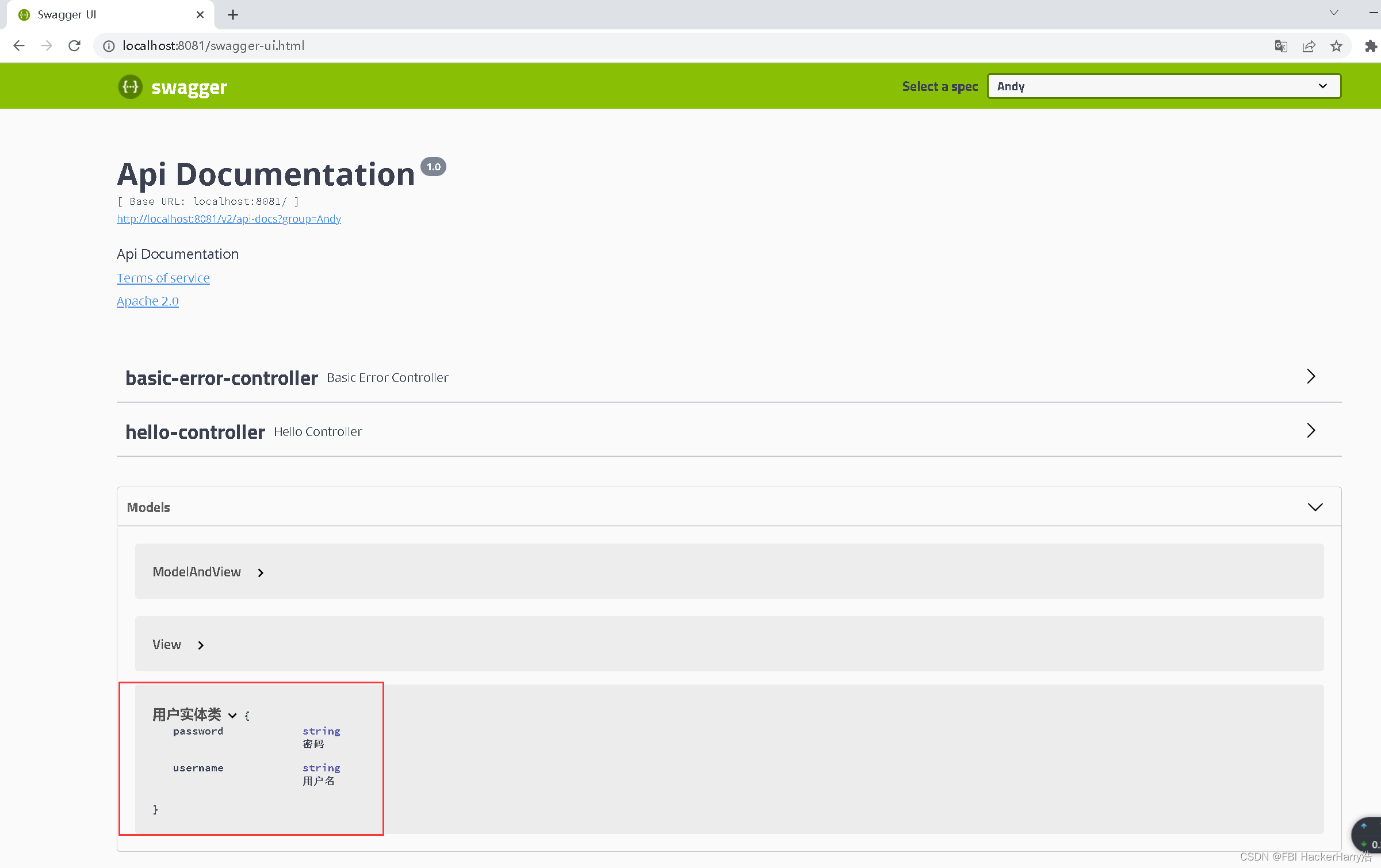
Operation接口,不是放在类上的,是方法
@ApiOperation(“XXX方法”) 添加在XXXController的方法上
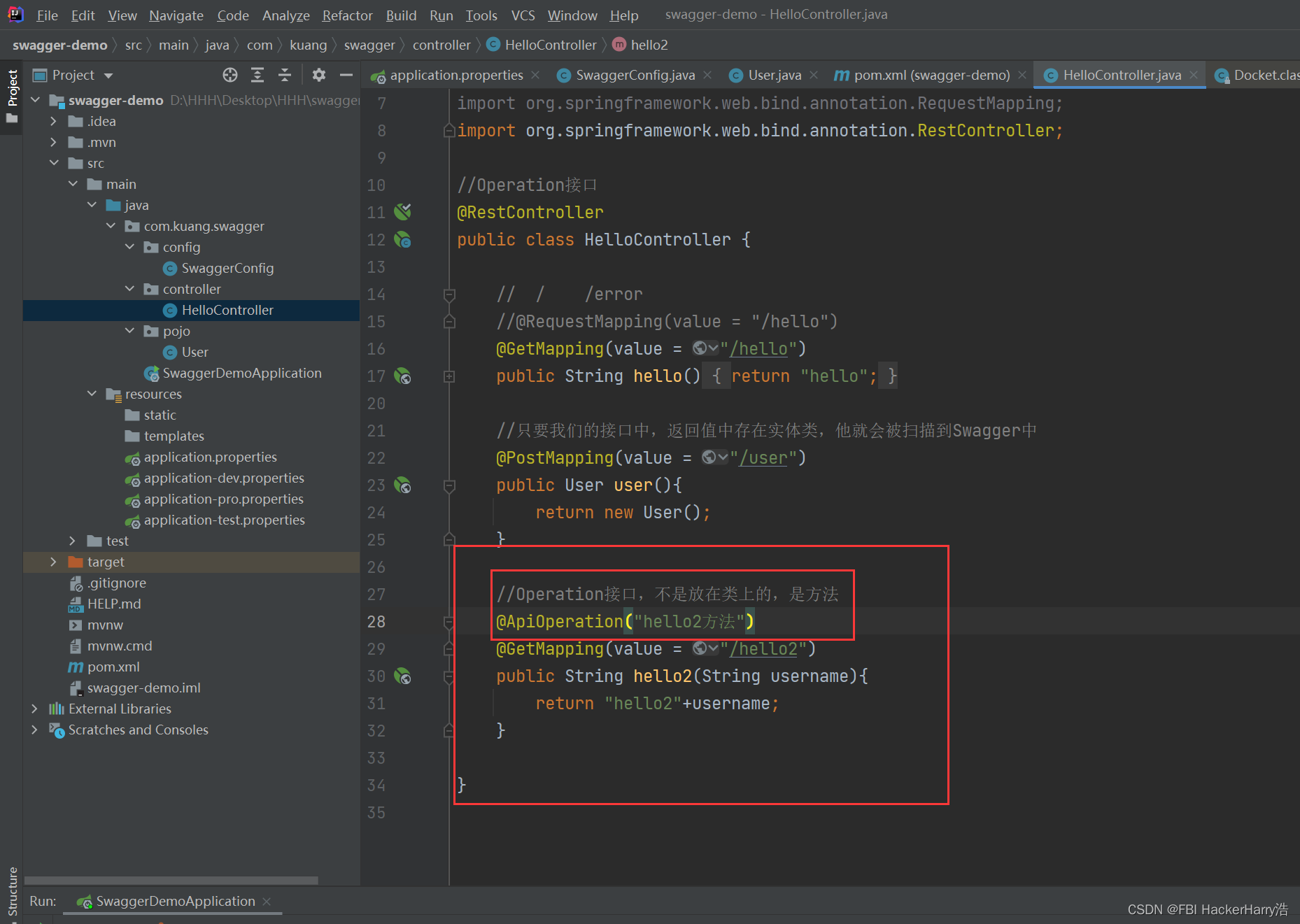
浏览器启动访问:http://localhost:8081/swagger-ui.html

@ApiParam(“方法的参数”)
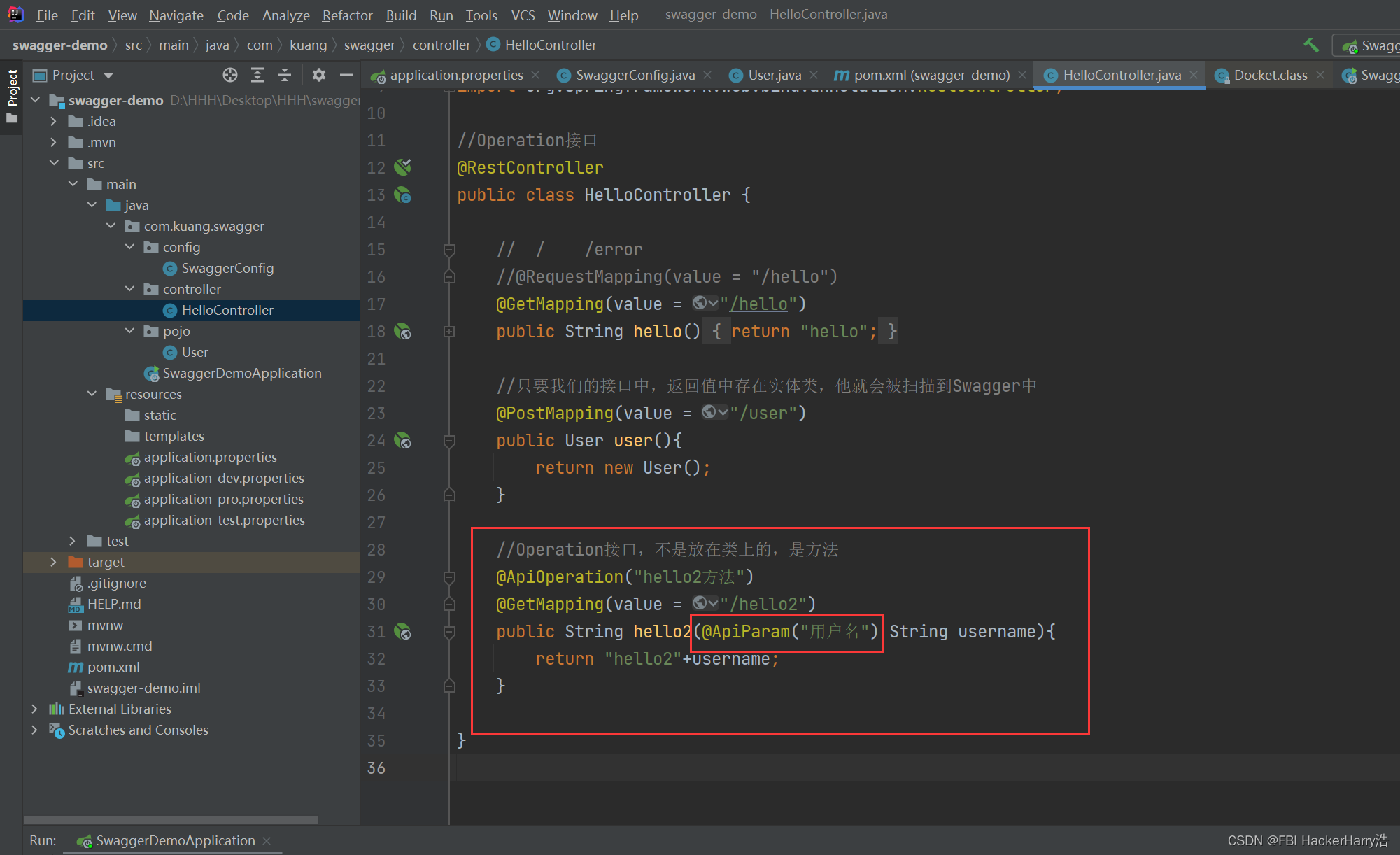
浏览器启动访问:http://localhost:8081/swagger-ui.html

八、测试
1.测试hello方法
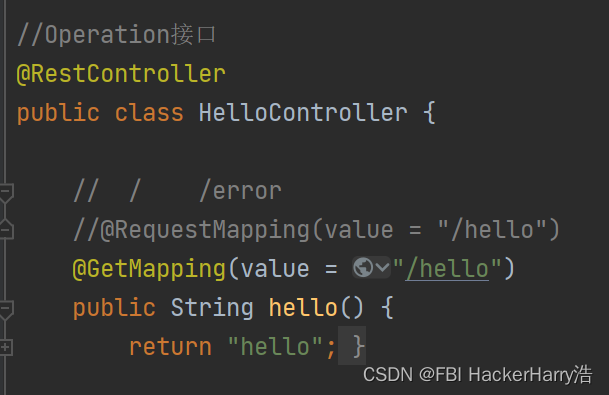
浏览器启动访问:http://localhost:8081/swagger-ui.html
找到HelloController的hello()方法
点击Try it out
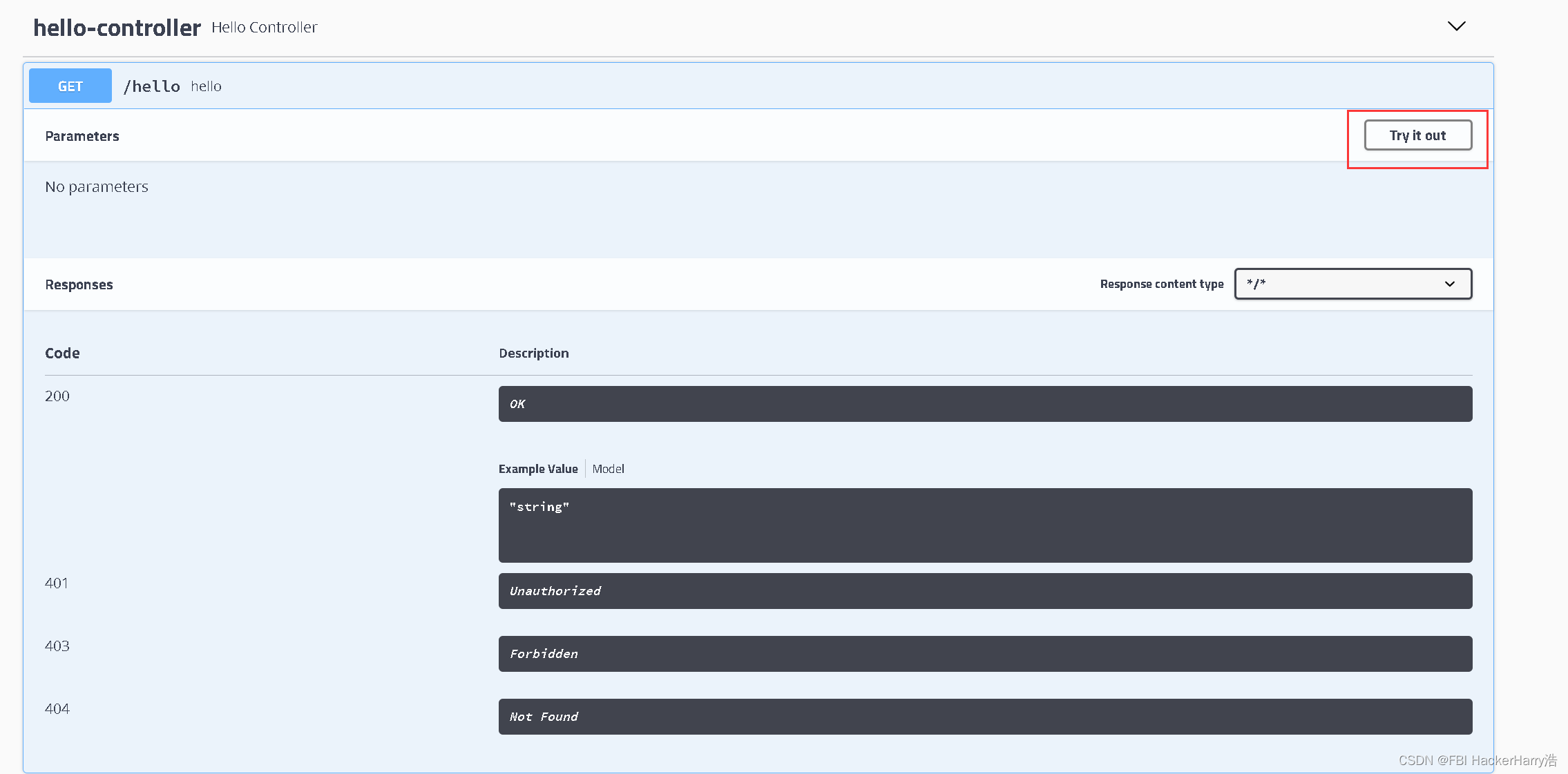
点击Execute执行
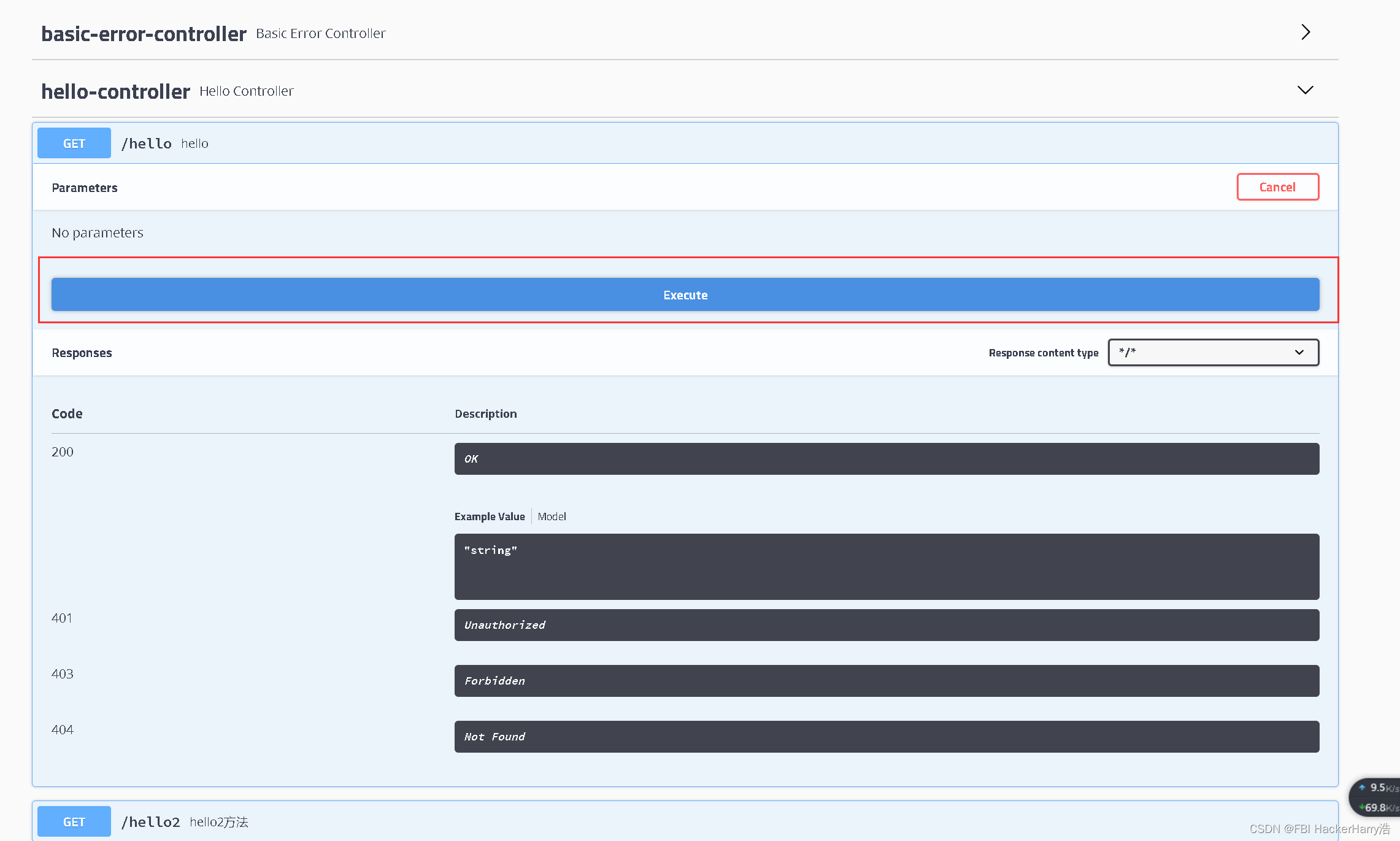
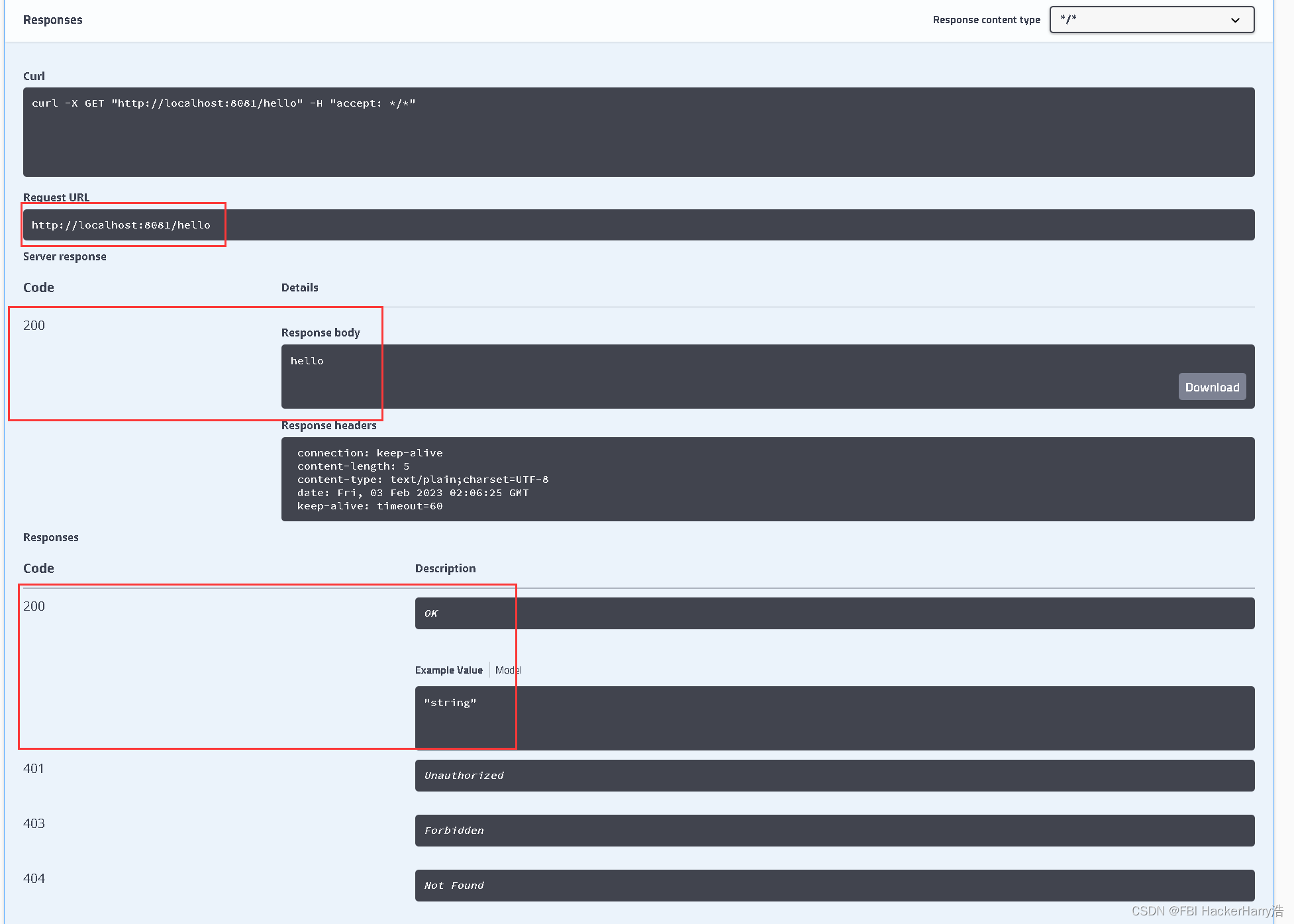
2.测试user()方法

浏览器启动访问:http://localhost:8081/swagger-ui.html


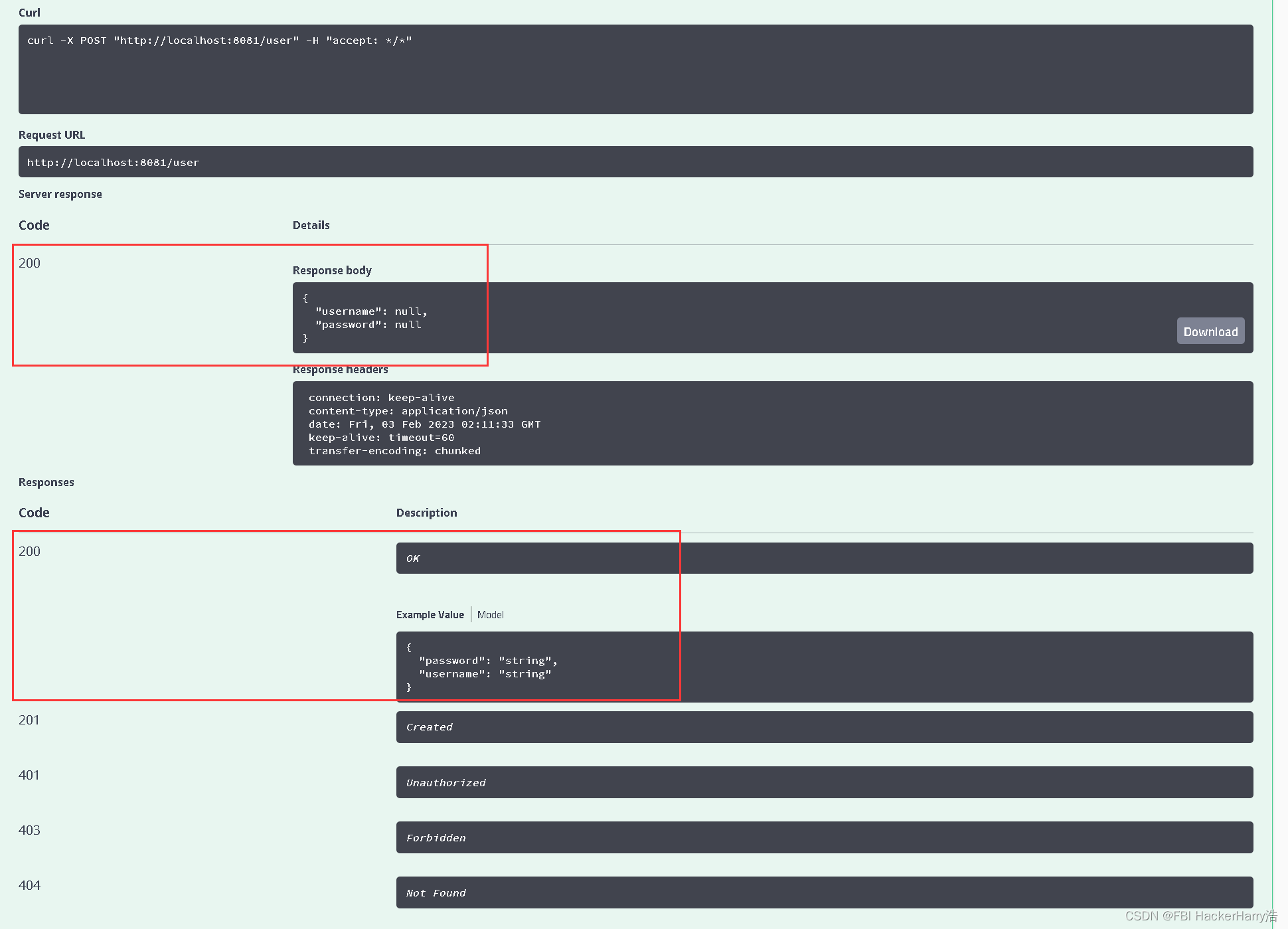
3.测试hello2方法
测试hello2方法,先将hello2的@GetMapping改成@PostMapping,并给方法中的参数加入@RequestBody注解
修改之前

修改之后

测试
浏览器启动访问:http://localhost:8081/swagger-ui.html
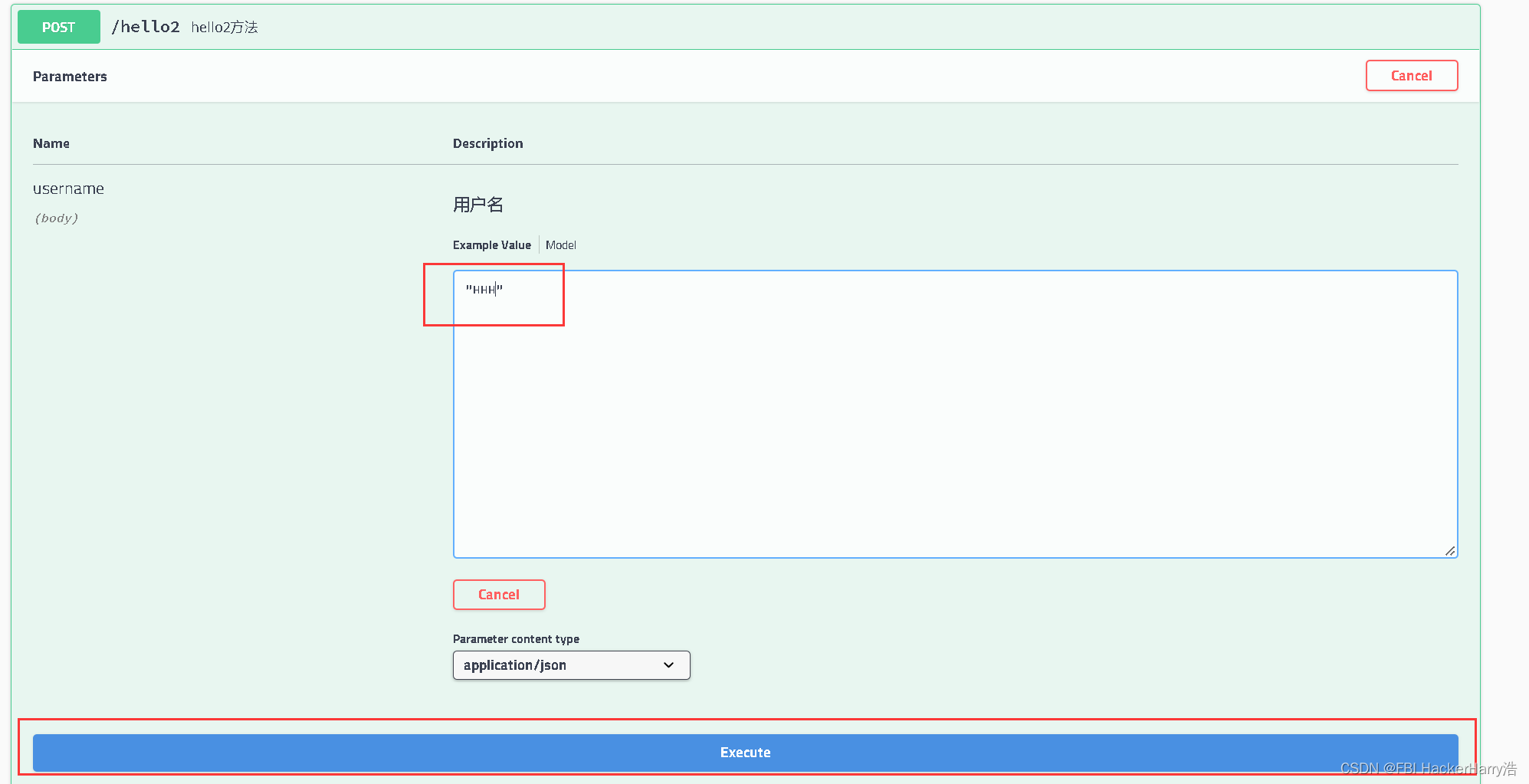

4.测试hello3方法

浏览器启动访问:http://localhost:8081/swagger-ui.html

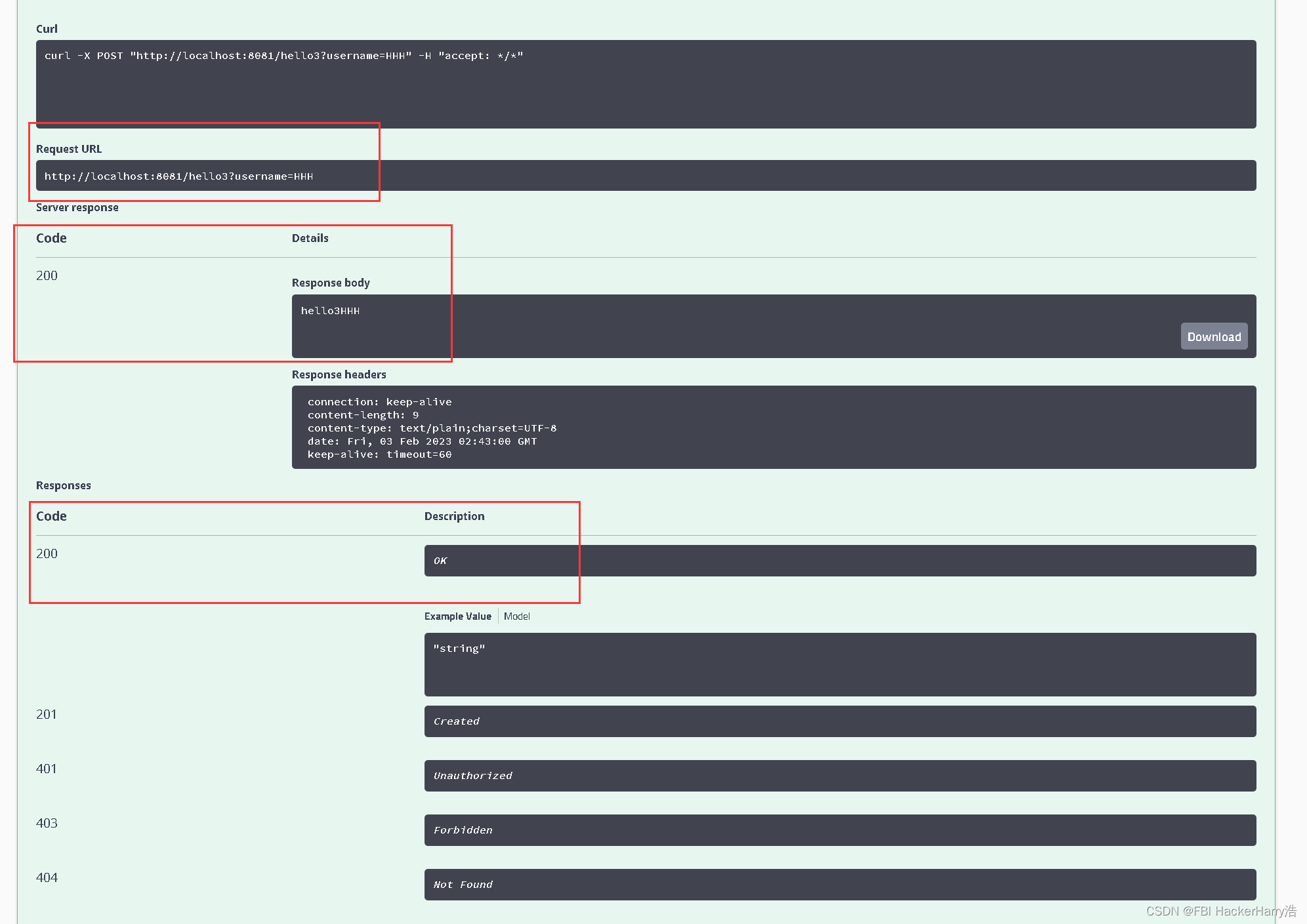
5.测试postt方法
5.1 直接传对象
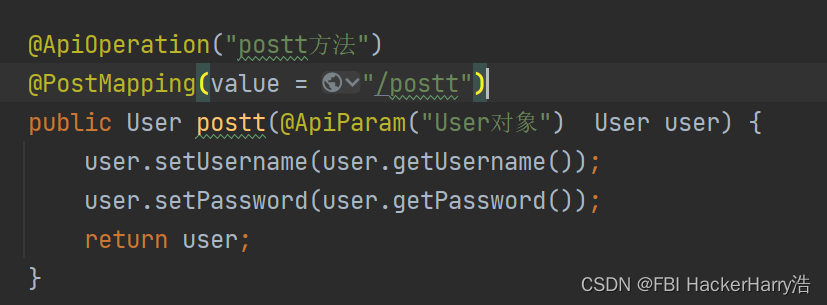
浏览器启动访问:http://localhost:8081/swagger-ui.html
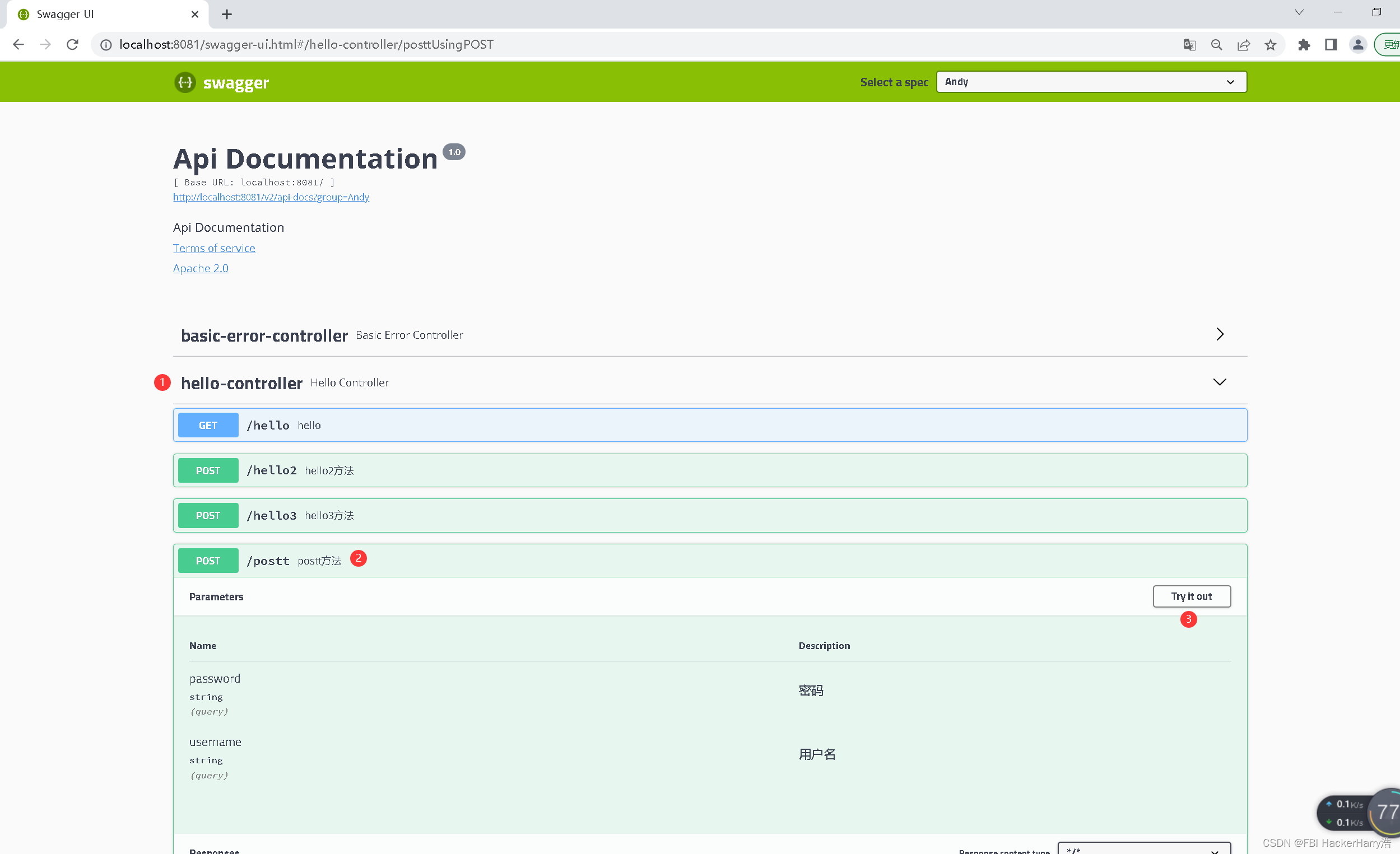


5.2 添加@RequestBody注解,则前端传一个JSON对象

浏览器启动访问:http://localhost:8081/swagger-ui.html
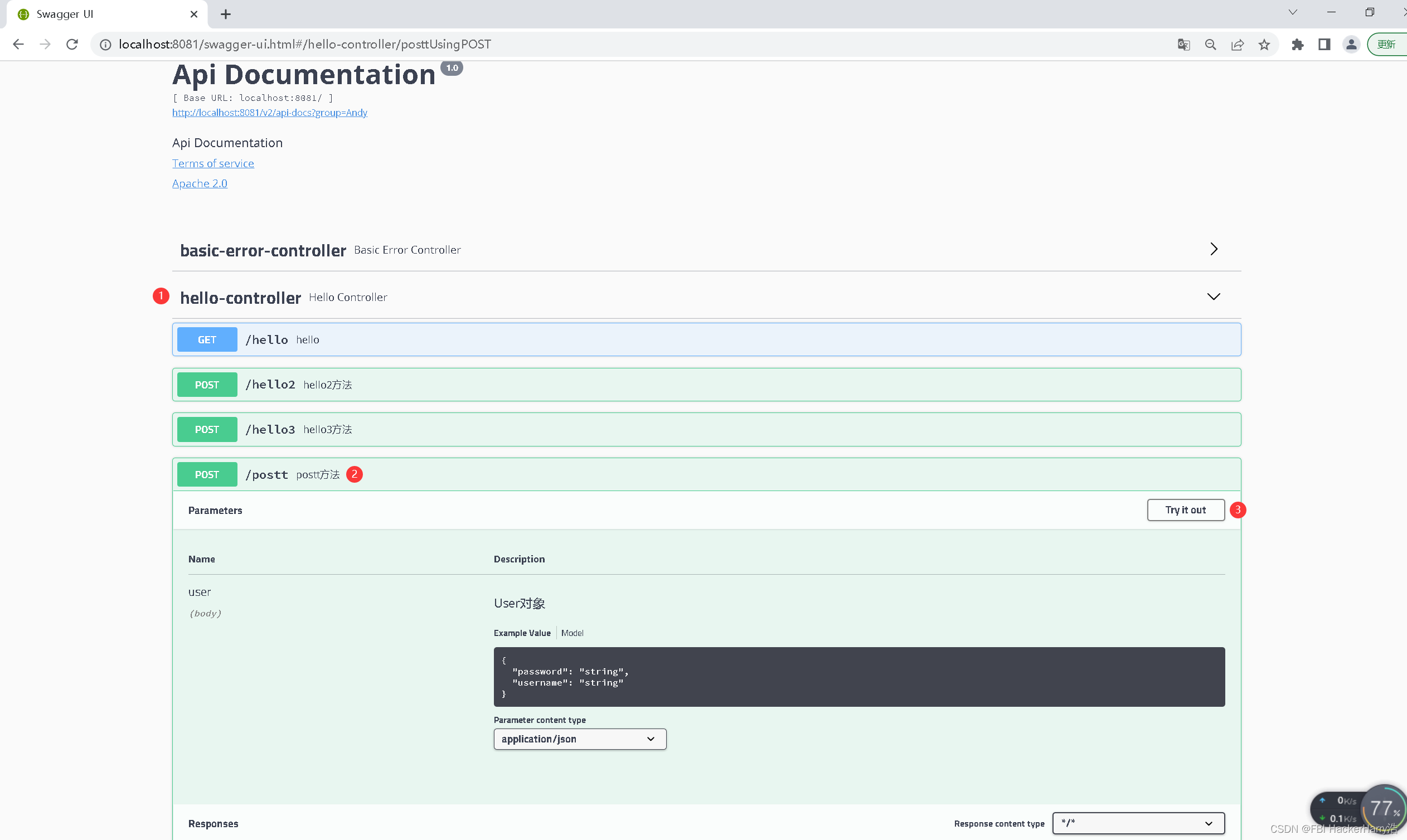

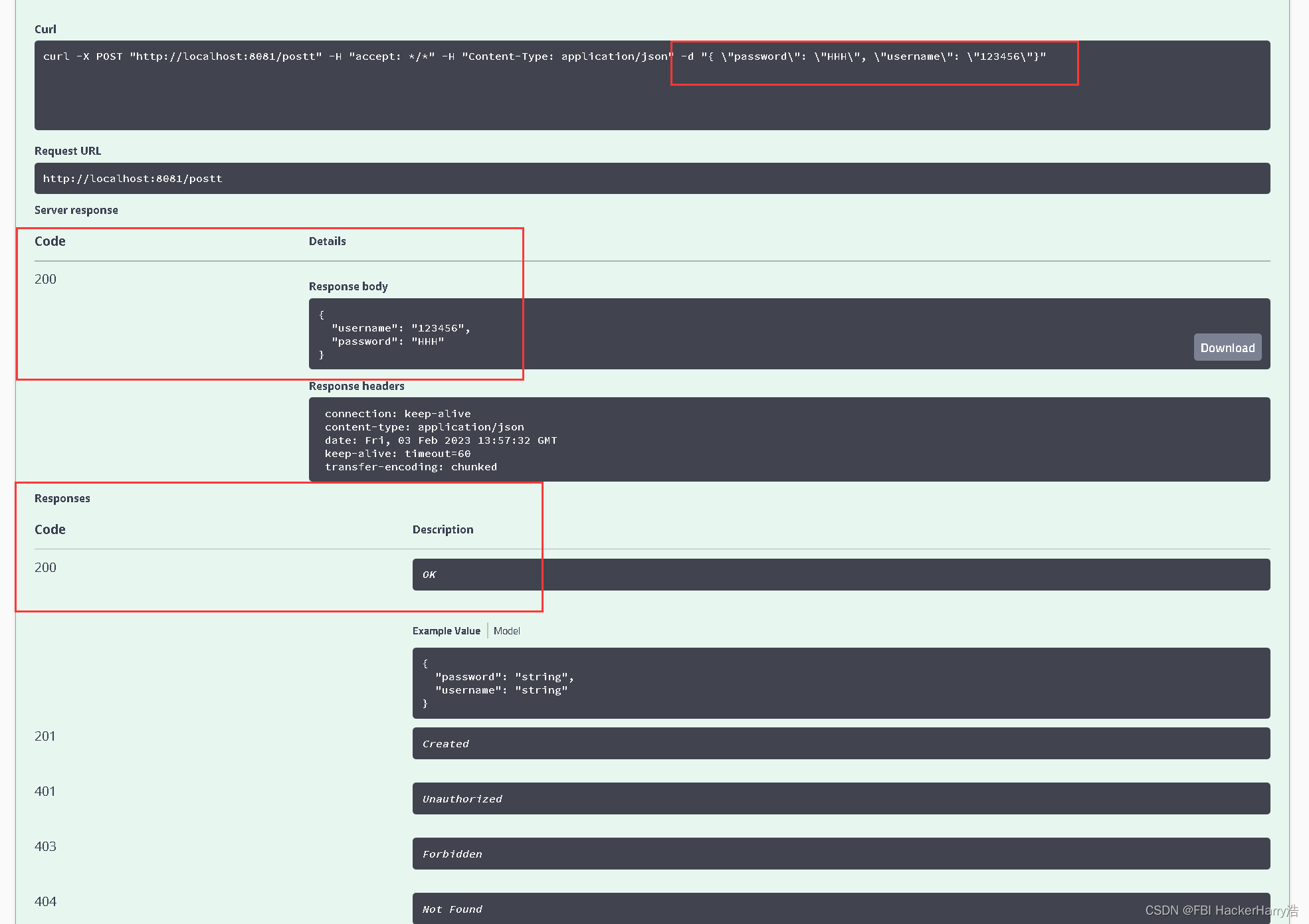
总结:
1.我们可以通过Swagger给一些比较难理解的属性或者接口,增加注释信息
2.接口文档实时更新
3.可以在线测试
Swagger是一个优秀的工具,几乎所有大公司都有使用它
【注意点】在正式发布的时候,关闭Swagger!!!出于安全考虑,而且节省运行的内存。